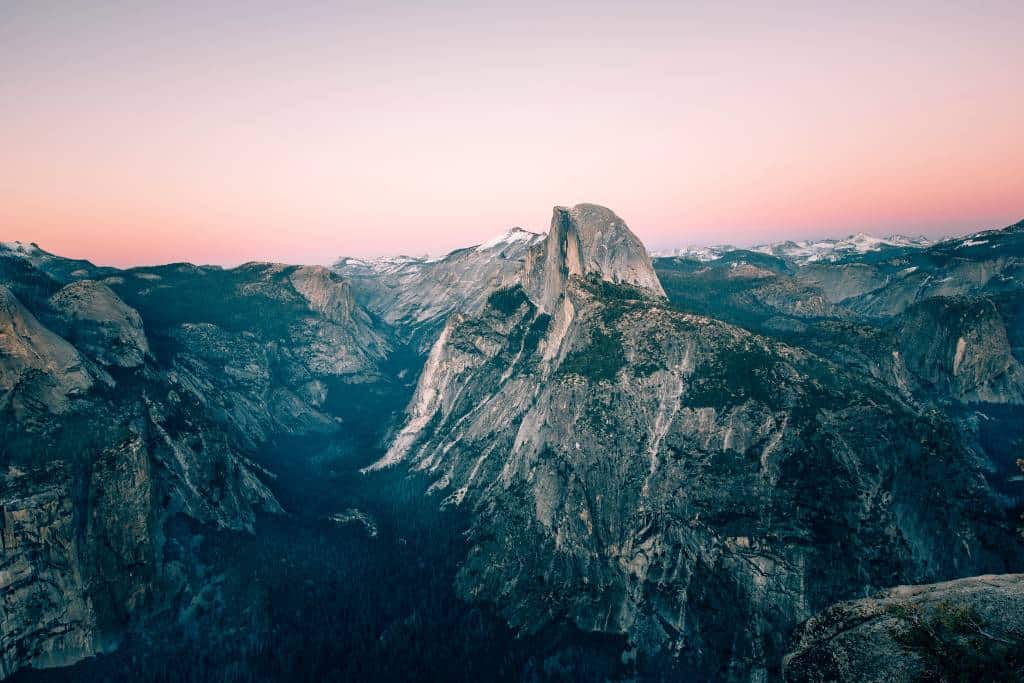The 32 Best West Coast National Parks (For Families)
At the Traveling Families Club, we are all about exploring with your family. National Parks provide one of the best opportunities to do so. So we put together this list of The 32 Best West Coast National Parks for families to help you decide which National Parks to add to your next vacation.
The West Coast of the United States is home to some of the most beautiful and diverse national parks in the world. From ancient redwood forests to towering mountain peaks, there’s something for everyone in these incredible outdoor destinations.
Whether you’re traveling to the west coast for the first time or looking for a new destination to explore, here’s what you need to know about the Best West Coast National Parks.
A Bit About Our List
We broke our list into three separate categories. In the first Section, we did a deep dive into the best 11 National Parks on the actual west coast, meaning parks in California, Oregon, and Nevada. These 11 are all must-visit parks and many are close enough together to combine into one trip.
When considering which parks to choose, we looked at ease of access, and availability of great things to do with your kids.
In Section 2, we expanded to include Alaska and Hawai’i and took a shorter look at the best National Parks these states have to offer, as well as the remaining parks in California and Washington that didn’t make our top 11.
Finally, in Section 3, we took a look at some of the best National Parks in the Western United States, that aren’t technically on the West Coast.
The parks are numbered 1 through 32 for ease of navigation throughout the article. Each section is organized by state so that if you are planning a trip to a particular region you can easily identify nearby parks.
Section 1
The Best West Coast National Parks: California
California is truly a nature-lovers paradise, boasting the most national parks of any state in America. From breathtaking coastlines to majestic mountain ranges, it’s easy to see why this sunny region deserves its reputation for outdoor adventure!
1. Yosemite National Park
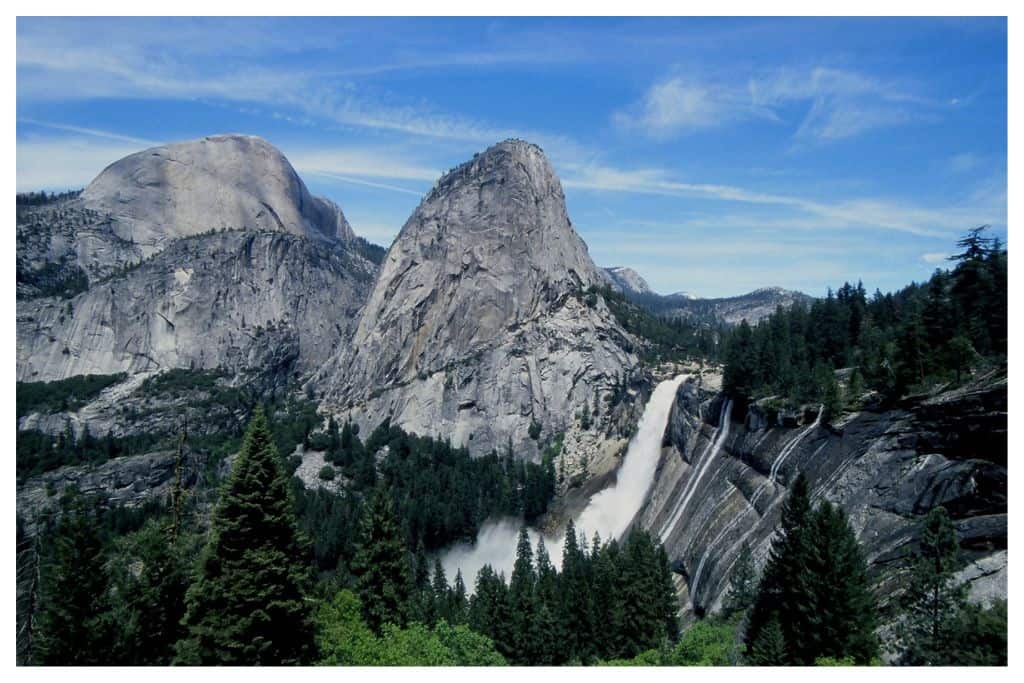
What Is Yosemite National Park Known For?
With its winding rivers, majestic waterfalls, and breathtaking rock formations, Yosemite National Park is a family-friendly paradise that offers countless ways to explore the natural wonders of this stunning landscape. From taking guided nature hikes through sun-drenched meadows or trekking along peaceful forest trails – your little adventurers are sure to have an unforgettable experience!
5 Great Things To Do With Kids in Yosemite National Park
- Rent bikes and tour the valley floor: Bike rentals are available in Yosemite Valley just in front of Curry Village. This is a great way to tour the valley floor with kids. They even have the option to rent a bike with an attached trailer for families with kids that don’t ride bikes yet.
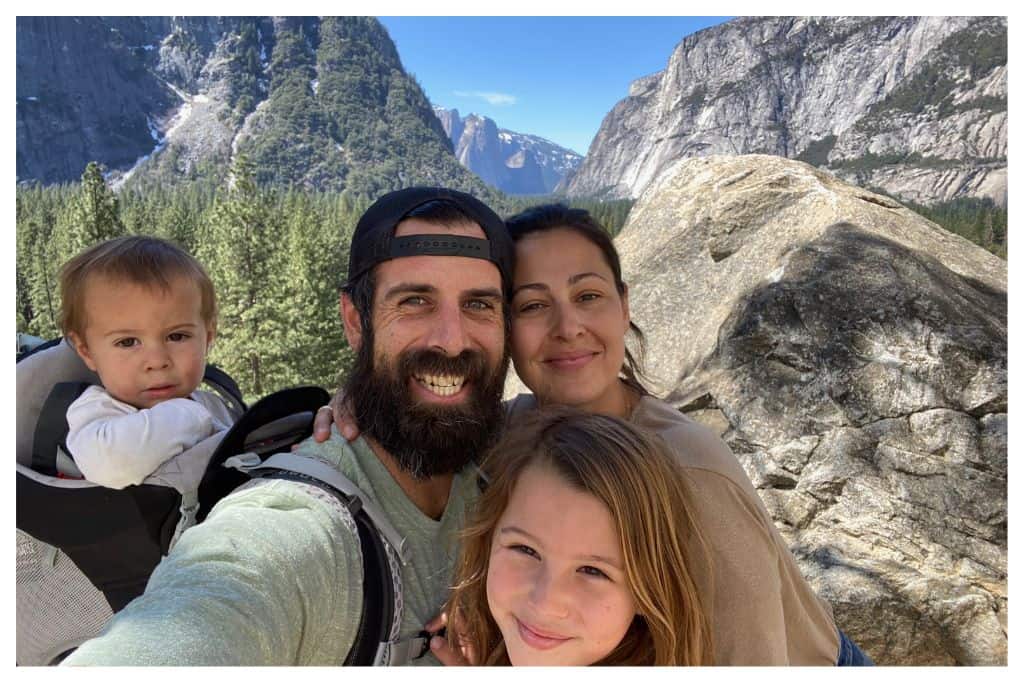
- Visit the Giant Sequoias: Yosemite is home to 3 groves of giant sequoias that feature some of the planet’s oldest and largest trees. These awe-inspiring trees reach heights of almost 300 feet. Some are as old as 3,000 years old.
- Join The Jr. Ranger Program: Yosemite offers a great Jr Ranger program. Kids can earn a Jr Ranger badge by completing a fun workbook. They will be sworn in by a park ranger upon completion of the program. It is a great way for your kids to learn about the park and have a motivating project to work on during your trip.
- Take a day trip to Tuolumne Meadows: Tuolumne Meadows is a high alpine meadow located within Yosemite National Park. It is completely different from, and yet equally as beautiful as Yosemite Valley. There are abundant hiking opportunities in Tuolumne Meadows. The Tuolumne River offers lots of great swimming holes to cool off on a hot summer day.
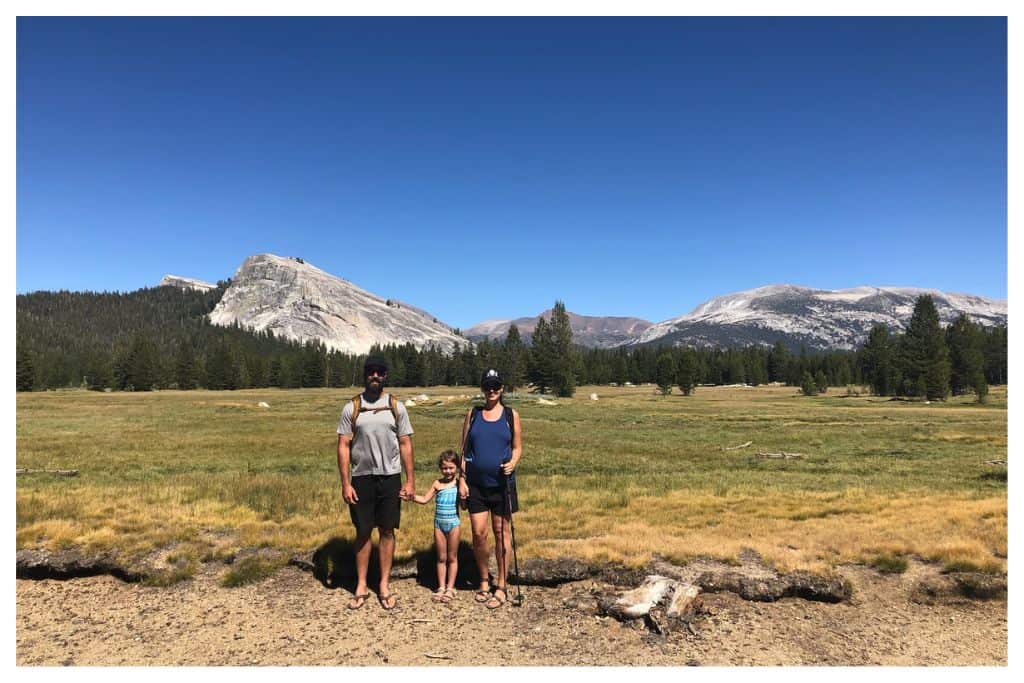
- Take a Drive To Glacier Point: Glacier Point is a viewpoint along the rim of Yosemite Valley. From the edge of the viewing platform, it is a 3,000-foot drop almost straight down to the Valley floor. The breathtaking view stretches for miles across jagged peaks, thundering waterfalls, and sprawling forests.
Best Time to Visit Yosemite National Park
Yosemite National Park is open year-round and every season has something unique to offer. However, the best time to visit is typically late spring and summer. This time of year typically features warm days with chilly nights. The water levels are highest earlier in the year, making the rivers and waterfalls even more dramatic.
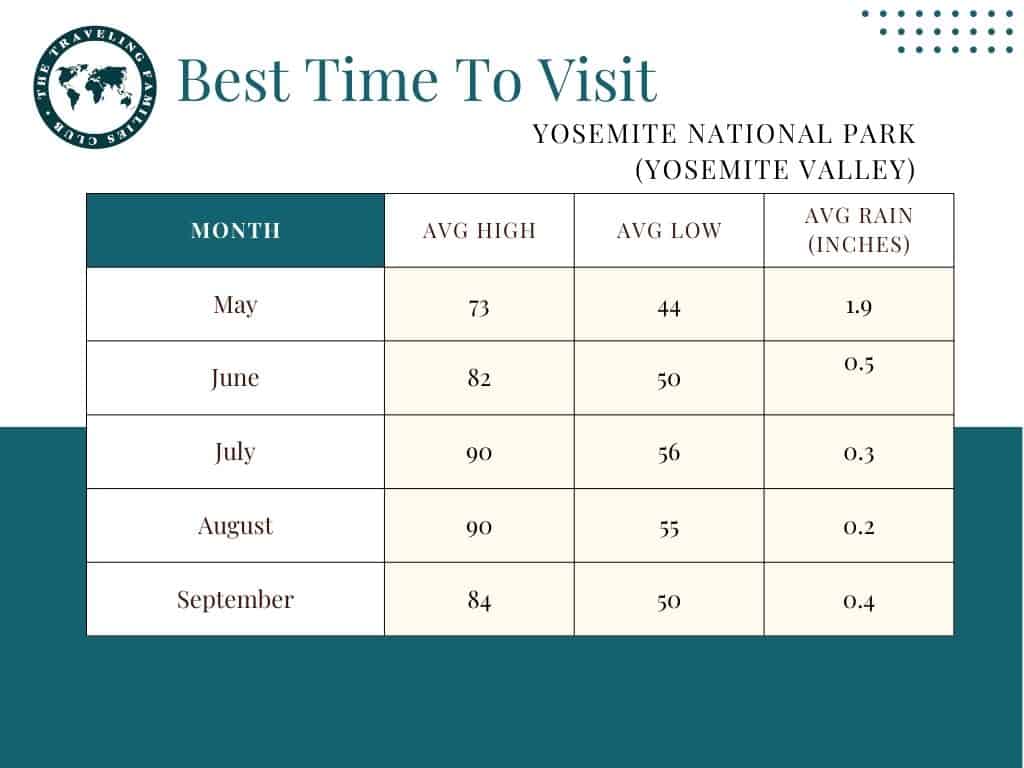
Where to Stay in Yosemite National Park
Due to traffic entering and exiting the park and limited parking available within the park, we highly recommend staying in the park. The best places to stay are either in Yosemite Valley or Tuolumne Meadows.
Hotels & Lodges
➡️ The Ahwahnee Hotel: Located in Yosemite Valley. A more luxurious option. The Ahwahnee is a beautiful lodge built in 1927.
➡️ Yosemite Valley Lodge: Located in Yosemite Valley near the base of Yosemite Falls. Offers both family and bunk rooms. Open year-round.
➡️ Wawona Lodge: Located in the southern section of the park near the Mariposa grove.
➡️ Curry Village: A more rustic option, providing basic tent cabins, a shared bath with hot showers, a cafeteria, a pizzeria, and a bar.
➡️ House Keepers Camp: Located in Yosemite Valley, House Keepers Camp is great for those who want the feel of camping but don’t want to bring all their own equipment. Each unit is a three-sided concrete structure with a canvas roof and a cloth wall on the fourth side. Units can sleep up to six people. All units come with a campfire ring and bear box for food storage.
Camping
There are a total of 13 established campgrounds in Yosemite. You can find the complete list here. If this is your first time visiting Yosemite we highly recommend either Yosemite Valley or Tuolumne Meadows as your destination. Our favorite campgrounds are;
➡️ Upper Pines Campground: There are a variety of campgrounds in and near Yosemite Valley. Our favorite is Upper Pines as it has some great places to play in the river right in front.
➡️ Tuolumne Meadows Campground: The only campground available in Tuolumne Meadows. This typically doesn’t open until late July to early August depending on the snowpack. Be sure to check with the National Park Service for exact dates.
For more information on Yosemite Check out our detailed write up Is Yosemite Worth Visiting?
2 – 3. Kings Canyon National Park and Sequoia National Park
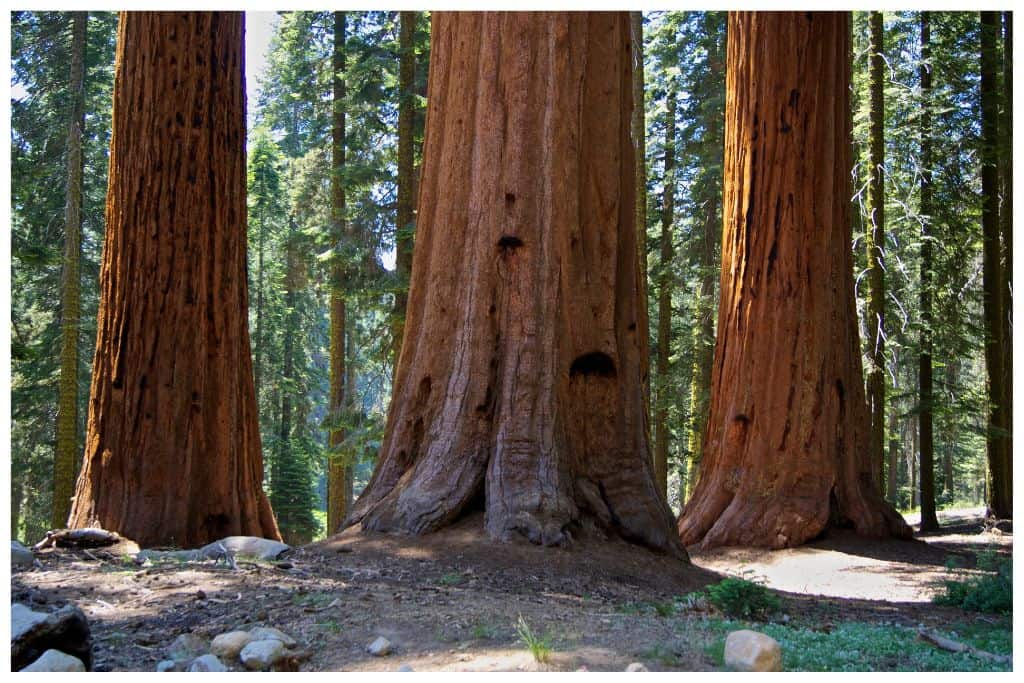
What are Kings Canyon and Sequoia National Parks Known For?
While technically separate National Parks, Kings Canyon and Sequoia are adjacent and you can easily visit both in one trip. The parks are most commonly visited for views of the Giant Sequoias from which Sequoia National Park derives its name. Although not visible from the western section of the park, Mt Whitney, the highest peak in the lower 48 states, also sits on the border of Sequoia National Park.
5 Great Things To Do With Kids In Kings Canyon and Sequoia National Parks
- Visit The Giant Forest and General Sherman Tree: The General Sherman tree is the largest tree in the world measured by volume. This ancient tree is roughly 2,200 years old, stands 275 feet tall, and is over 36 feet in diameter at its base.
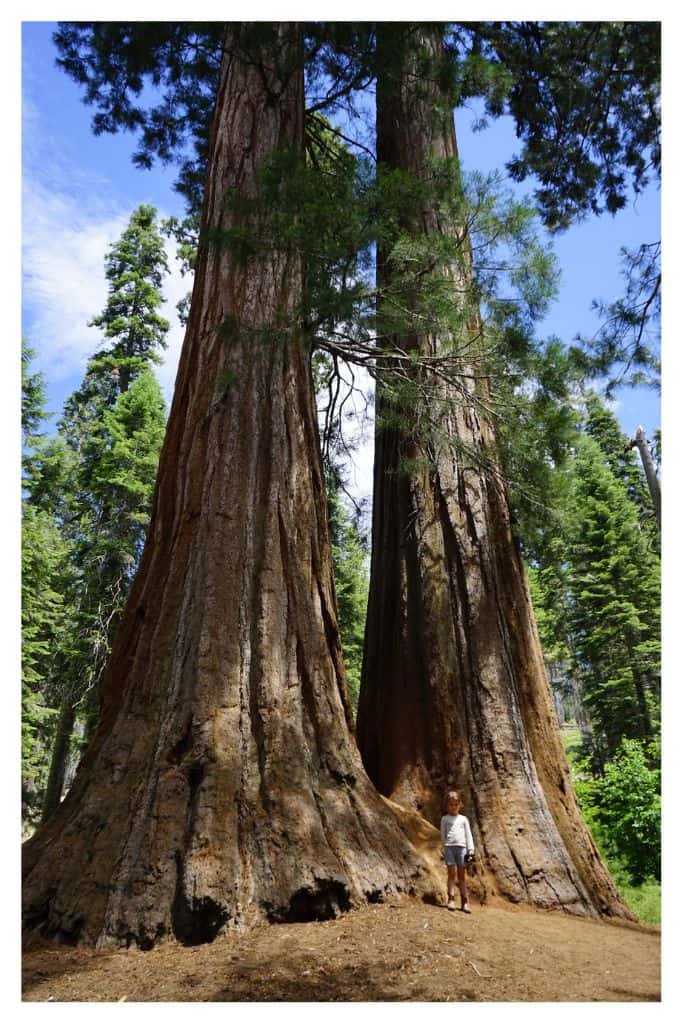
- Visit The General Grant Grove: The General Grant Grove is great for kids. The trail is relatively flat and easy to hike, a section of the trail actually passes through the hollowed-out trunk of a fallen sequoia. The Grove is also home to the historic Gamlin Cabin built in 1872.
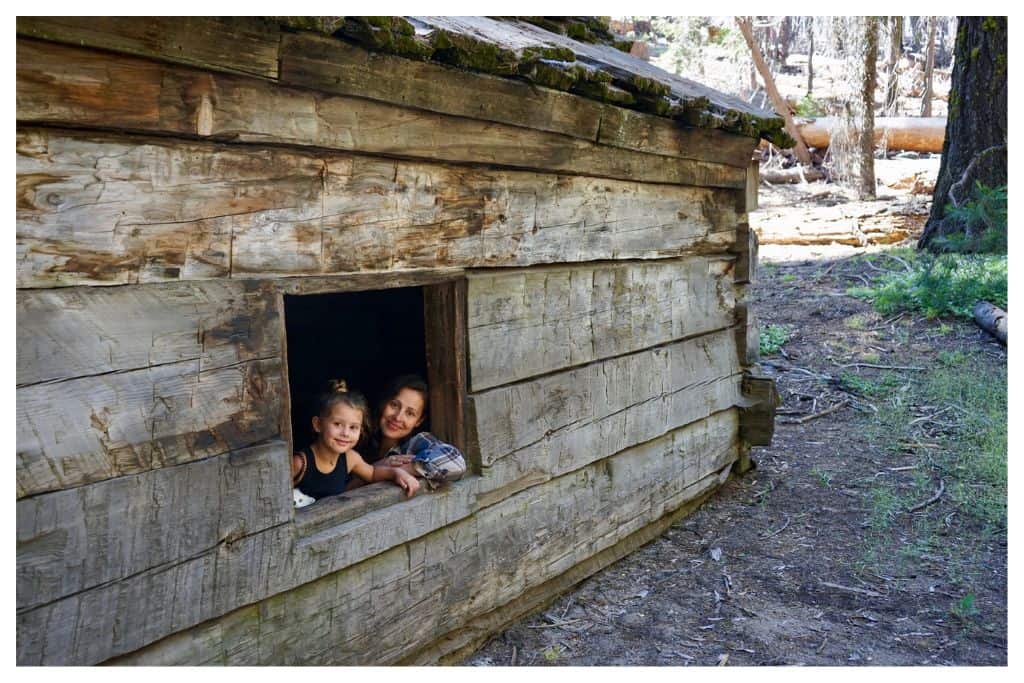
- Tour the Boyden Cavern: Appropriate for all ages, this limestone-lined cavern offers a unique opportunity to explore one of nature’s underground works of art. Take an unforgettable journey into its enchanted depths full of dazzling stalactites and still pools illuminated by gentle lighting.
- Go for Swim In Hume Lake: While Hume lake is technically not in the National Park boundary you do not need to pass through a park gate to access it. This high alpine lake is relatively warm and a great place to go for a swim on a hot summer day.
- Hike Zumwalt Meadow: This 1.5-mile loop trail is relatively easy and flat. The trail winds along the Kings River and through the lush Zumwalt Meadows. All while offering magnificent views of the surrounding granite cliffs.
Best Time To Visit Kings Canyon and Sequoia National Parks
The best time to visit Kings Canyon and Sequoia National Parks is from late spring through the summer.
The earlier you go in the year the water levels will be higher. The days will get progressively warmer throughout the summer. You can expect chilly mornings and evenings throughout the summer.
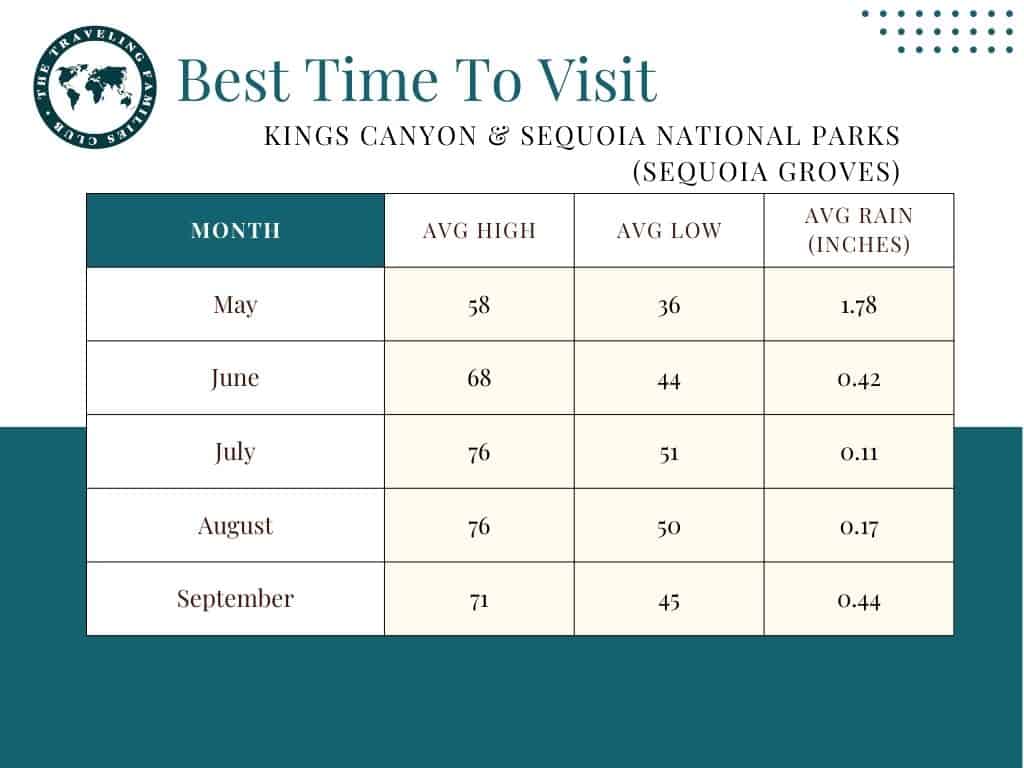
Where to Stay In Kings Canyon and Sequoia National Parks
There are numerous options for both camping or hotels/cabins within Kings Canyon and Sequoia National Parks. If your goal is to combine both parks into one trip we recommend staying near the General Grant Grove due to its central location.
Hotels & Lodges
➡️ Wuksachi: Located in the Giant Forest area of Sequoia, Wuksachi is a more modern lodge.
➡️ John Muir Lodge: This beautiful stone and timber retreat is open seasonally from March through October.
➡️ Grant Grove Cabins: Located in the General Grant area of Kings Canyon these stand-alone cabins are great for families that need a little more space than a typical hotel room.
➡️ Cedar Grove Lodge: Located in the canyon area of Kings Canyon National Park. This is a relatively small lodge with only 21 rooms.
Camping
Between Sequoia and Kings Canyon there are a total of 14 established campgrounds. You can find the complete list and details here.
Our preferred Campground is;
➡️ Sunset Campground: A typical national park campground. Within walking distance of the Grant Grove Village and general store.
4. Joshua Tree National Park
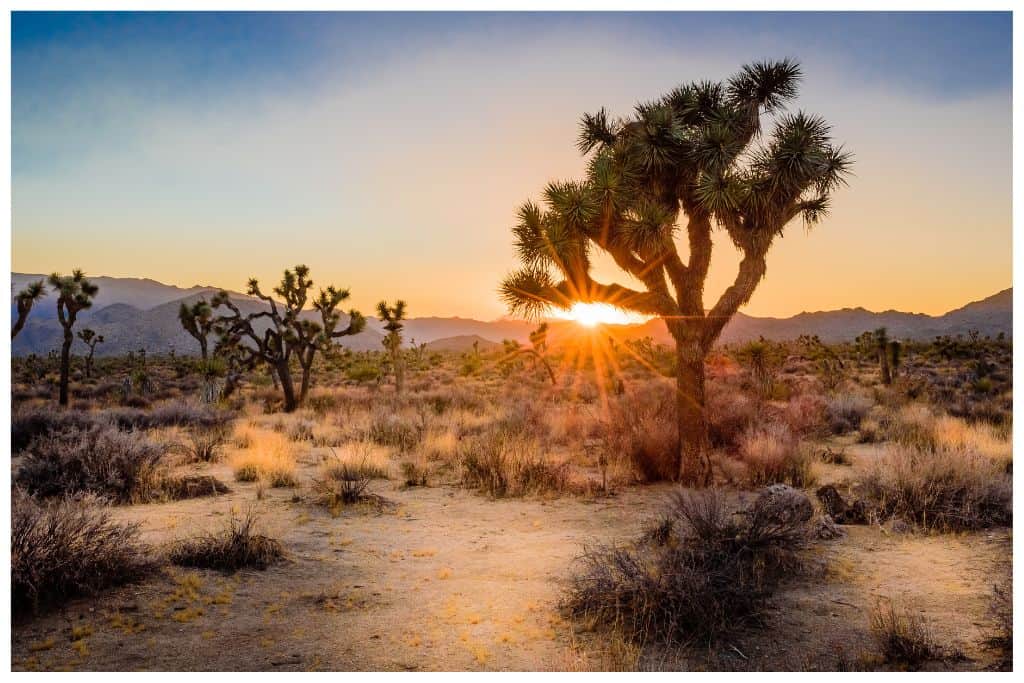
What Is Joshua Tree National Park Known For?
Joshua Tree National Park is a unique and stunning destination renowned for its dramatic landscapes. Here, you can explore miles of desert wilderness filled with awe-inspiring rock formations and some of the most beautiful Joshua Trees in existence.
5 Great Things To Do With Kids In Joshua Tree National Park
- Hidden Valley Nature Trail: An easy 1-mile loop trail surrounded by rock walls on all sides, that was believed to be a cattle rustlers’ hideout. There is also a great picnic area full of rock formations that are both great for photography and kids to climb on.
- Barker Dam Nature Trail: This easy and flat 1.3-mile trail is a great option because it offers a little bit of everything Joshua Tree has to offer. Joshua trees, large boulders, remnants of ranching efforts, and rock art that dates back thousands of years.
- Cholla Cactus Garden: A flat and easy trail wanders through nearly 10 acres of teddybear cholla. While teddybear cholla normally grows in small patches there are thousands of them in this natural garden.
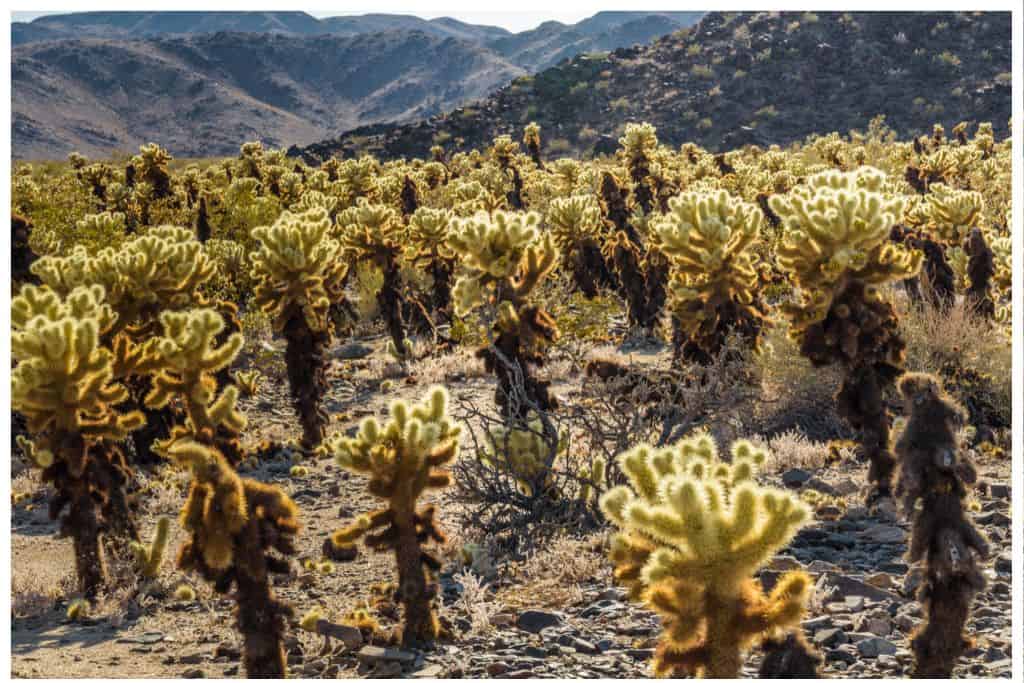
- Off-Road Tour: A fun way to reach otherwise inaccessible areas of the park and add a little excitement is via a 4×4 tour. This a great way to get away from the crowds.
- Keys Ranch Tour: The historic Keys Ranch is a homestead built by the Keys family in the 1910s. Now a national historic register site, you can take a guided ranger tour through the property that includes the original ranch house, schoolhouse, store, and workshop.
Best Time To Visit Joshua Tree National Park
The best time to visit Joshua Tree National Park is March-May and October-November. The most comfortable temperatures will be during these times with highs in the 70s-80s and lows in the 40s-60s.
Temperatures in the summer months regularly top 100 degrees with little to no shade.
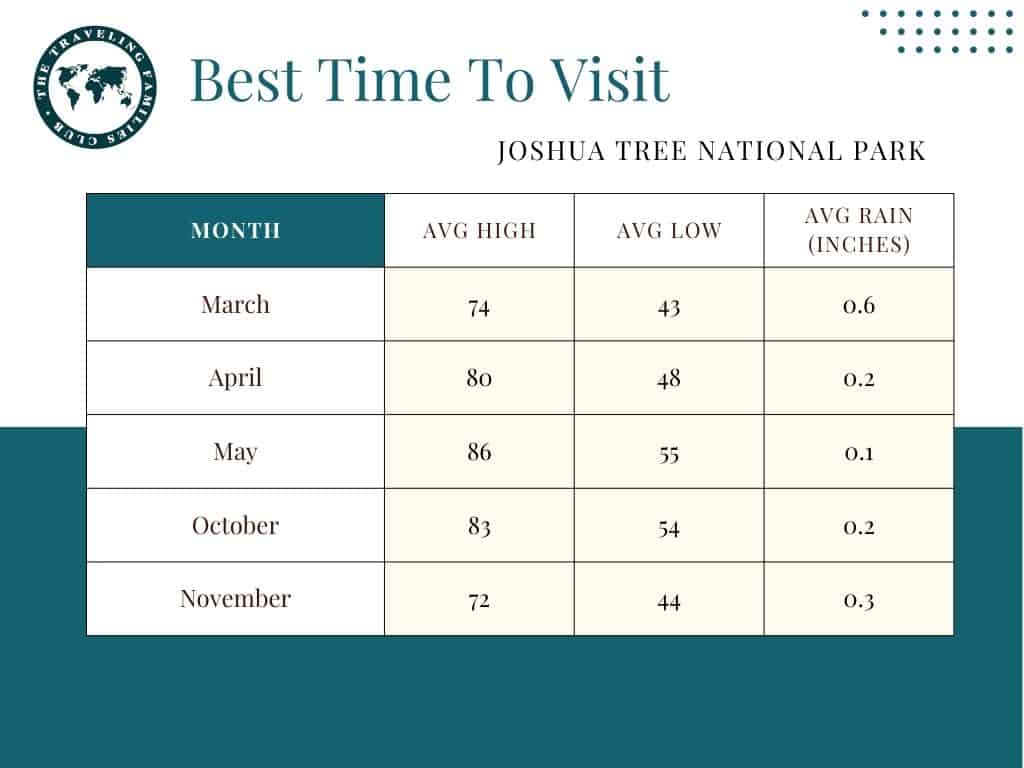
Where To Stay In Joshua Tree National Park
Hotels
While there are many accommodations to choose from in the area surrounding Joshua Tree National Park the only option for staying in the park is camping.
Camping
There are a total of 8 campgrounds within the park. You can find the complete list here.
Our recommendations are;
➡️ Jumbo Rocks Campground: Nice because it is centrally located. The drawback is that it does not have water. You will have to fill up water at the ranger station.
➡️ Cotton Wood Campground: The advantage of Cotton Wood is that it does have water, flush toilets, and a dump station (if you are in a trailer or RV). The drawback is that it is located on the southern edge of the park, and thus requires a bit more drive time to get to and from your daily outings.
5. Pinnacles National Park
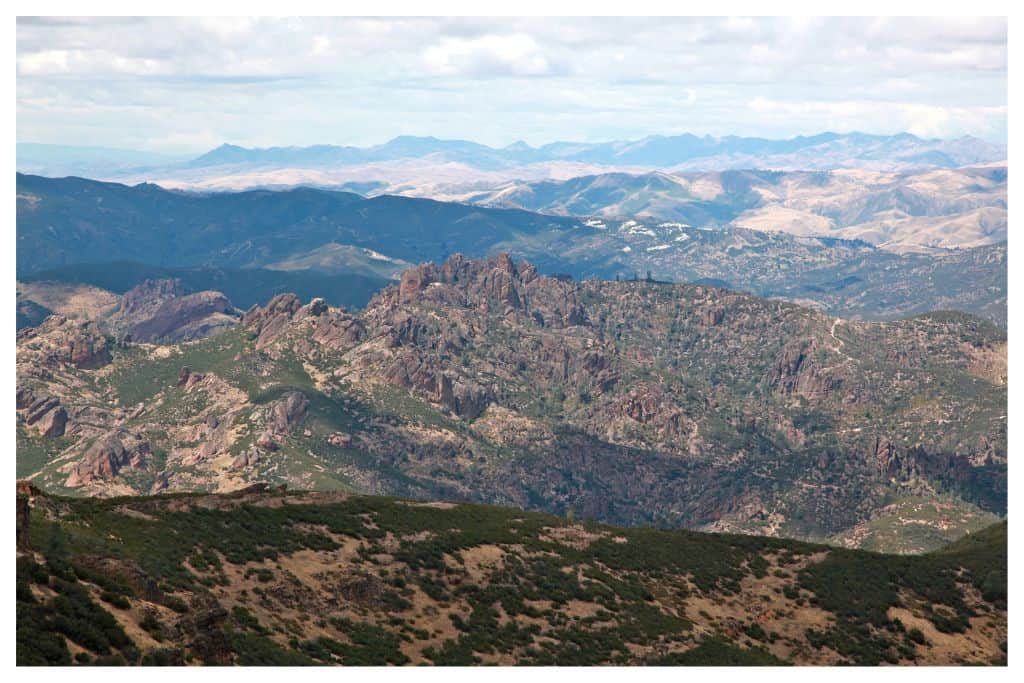
What Is Pinnacles National Park Known For?
Pinnacles National Park holds a special place in our hearts and makes it to our list of the Best West Coast National Parks as it is the closest National Park to our home! Covering just 41 square miles Pinnacles is one of the smallest national parks in the county.
It is best known for the jagged rocky peaks from which the park derives its name. It is also one of the few remaining places on the planet where California Condors, the largest flying bird in North America, live in the wild.
5 Great Things To Do With Kids In Pinnacles National Park
- Bear Gulch Reservoir Trail: This 1.2-mile out-and-back trail climbs 300 feet to the Bear Gulch Reservoir. The trail winds along, through, and under some of The Pinnacles’ wondrous rock formations. The Bear Gulch Cave is home to a colony of Townsend big-ear bats. The Cave is open seasonally depending on the health of the colony.
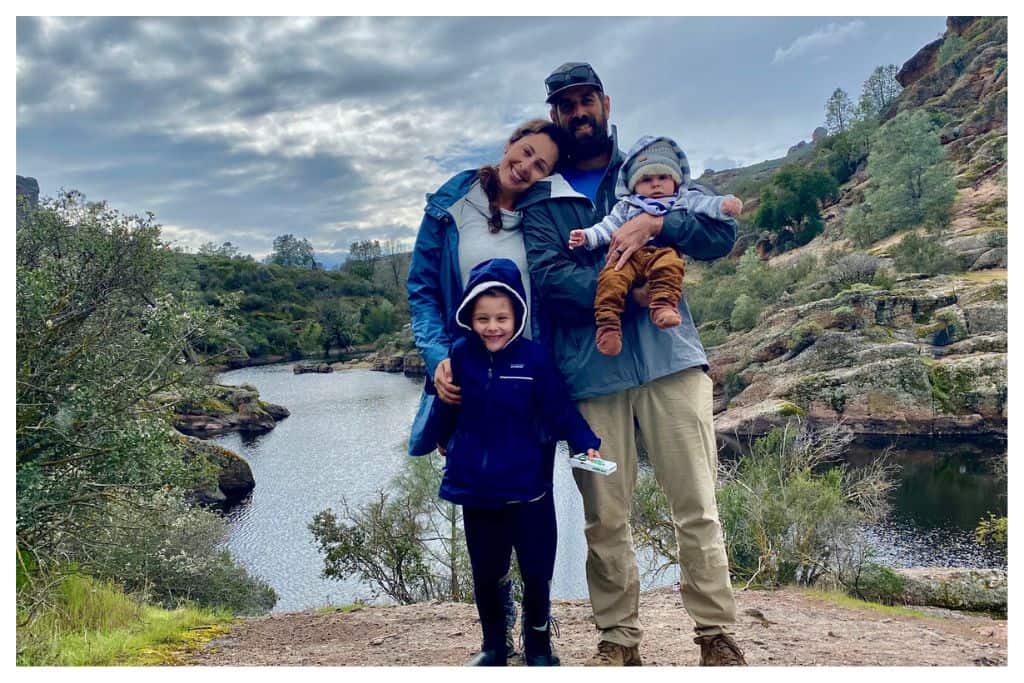
- Hike the Old Pinnacles to Balconies Trail: The Old Balconies trail can be accessed from either the east or west side of the park. The highlight of this trail is the Old Balconies Caves, which are talus caves, formed when large boulders fell into a narrow ravine covering the top and leaving a cave below. Be sure to bring a flashlight as there are sections of the caves where you need it!
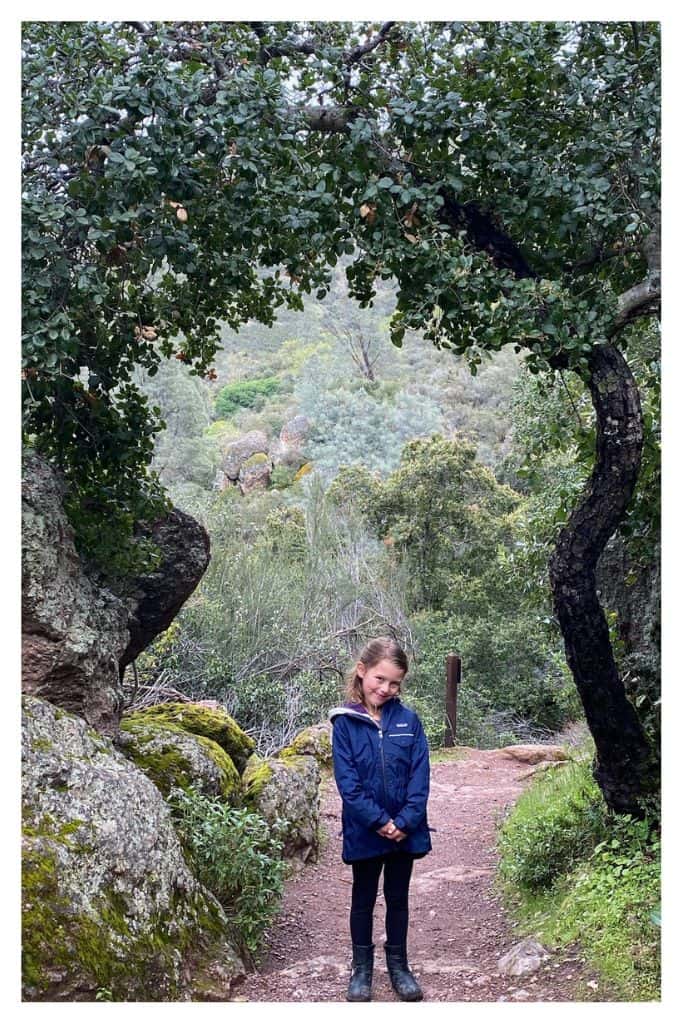
- Star Gazing: The Pinnacles’ typically dry conditions and distance from any major cities make it a great location for star gazing. Bundle up, turn off your lights, and take in the show.
- Look For Condors: Once thought to be extinct the California Condor is the largest flying bird in North America and one of the largest in the world. Pinnacles National Park is one of the few places where you can see these magnificent animals. Talk to a Ranger about how to identify the Condor and distinguish it from the relatively common turkey vulture that also calls The Pinnacles home.
- Go For a Swim in the Pool: The Pinnacles can often get quite hot. Thankfully, the campground actually has a pool! The pool is a vestige of when the area used to be privately owned. It is a great way to cool off after a hot day of hiking and exploring.
Best Time To Visit Pinnacles National Park
The best time to visit Pinnacles National Park is in the spring. The summer months at the Pinnacles can be very hot (100+ regularly) and dry. The spring will bring cooler temperatures, greener vegetation, and potentially wildflowers blooming.
The fall and winter can also be nice times to visit the Pinnacles, however, be advised that it can get cold, with sub-freezing temperatures being a regular occurrence at the Pinnacles in winter.
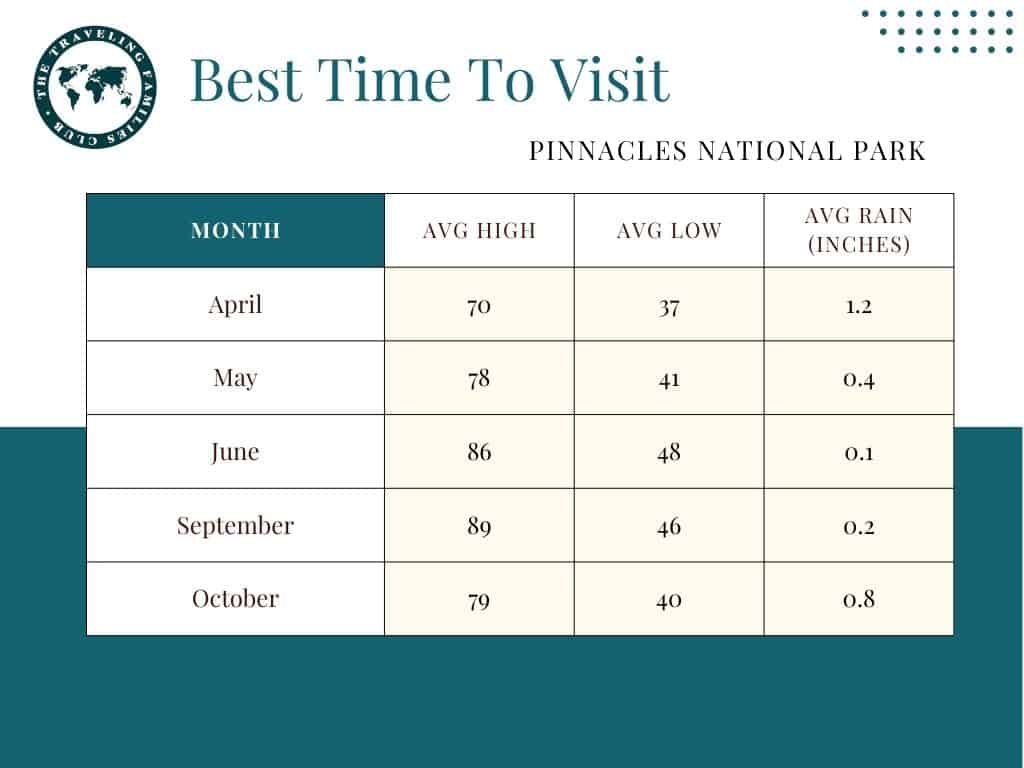
Where To Stay In Pinnacles National Park
The only option to stay in Pinnacles National Park is the campground on the Eastside of the Park. The campground has traditional campsites, an RV loop with electrical hookups, and has recently installed a few tent cabins.
6. Death Valley National Park
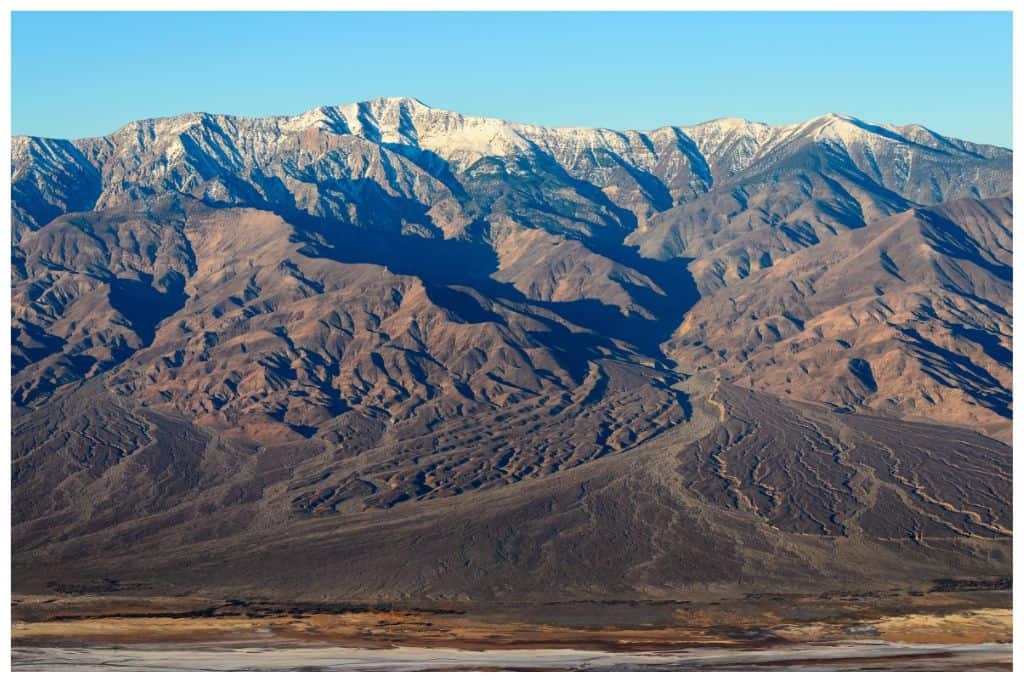
What Is Death Valley National Park Know For?
Located in eastern California, this National Park is well known for its arid desert climate and incredible contrasts between life and death that are seen throughout its landscape.
Death Valleys Badwater Basin is the lowest point in North America at 282 feet below sea level. Death Valley is also the location of the hottest officially recorded temperature in the world, at 134.1 degrees Fahrenheit!
From shifting sand dunes and rugged canyons to wildflowers appearing despite its dryness; there is something unique at every turn. Spend your time exploring this vast desert wonderland and enjoy the serenity of nature that envelops you from start to finish.
5 Great Things To Do With Kids In Death Valley National Park
- Darwin Falls: Constantly keeping you on your toes, another of Death Valley’s many surprises is the year-round waterfall of Darwin Falls. The hike to the falls is relatively short at only 2 miles. Remember that you won’t see water for much of the walk as it disappears beneath the ground. Not until you reach the head of the valley will you be rewarded with the cool falls and green vegetation.
- Mesquite Flat Sand Dunes: The Mesquite Flat Dunes are one of five dune fields within the park. They are the most visited because they are the most easily accessible. There is a paved parking lot, and while there is no formal trail to the dunes you can reach them within half a mile. A round-trip hike to the tallest of the dunes is around 2 miles.
- Artists Drive: This 9-mile scenic drive winds through fantastically colored hills that are the product of volcanic deposits. There are multiple viewpoints along the drive to stop for a photo. If you are a Star Wars fan you may also recognize the scenery from Star Wars Episode IV: A New Hope, scenes from the movie were filmed here.
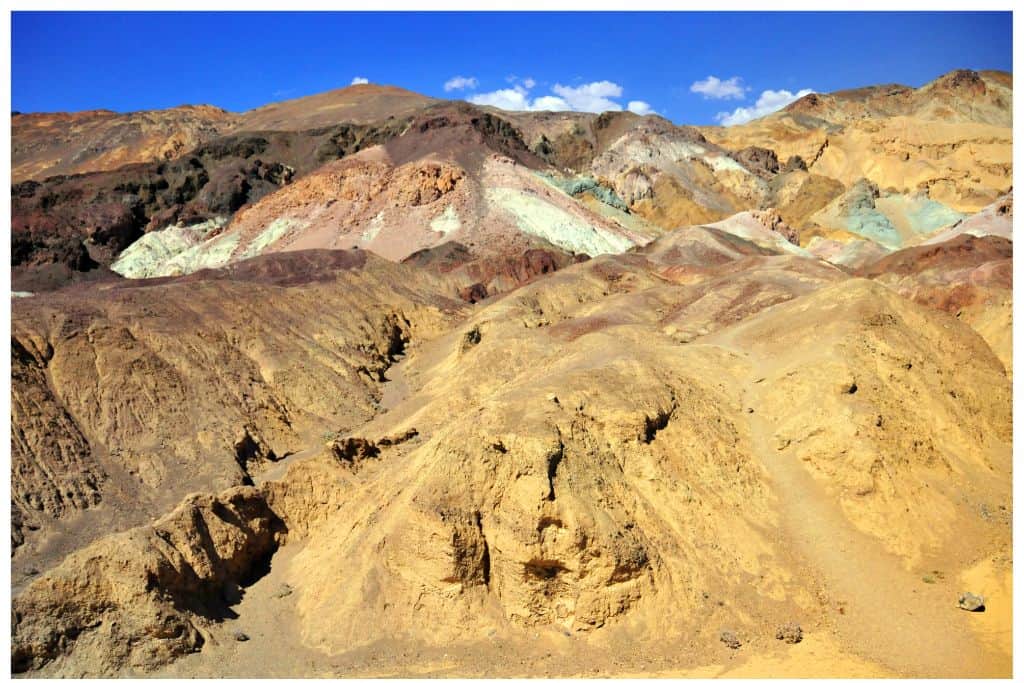
- Harmony Borax Works: Now a National Historic Register Site, the Harmony Borax Works was a functional Borax mine during the 1880s. The remnants of the mine and support buildings can be seen.
- Zabriskie Point: One of the most well-known viewpoints in Death Valley National Park. It is a short walk from the parking area to the viewpoint where you can look down upon the badlands and salt flats with the Panamint Mountains serving as a backdrop.
Best Time To Visit Death Valley National Park
The best, and most popular time to visit Death Valley is the spring. In addition to favorable weather, warm but not too hot, there is the possibility of wildflowers.
Late Fall and Winter can also be good times to visit Death Valley. The nights will be colder and lows can drop into the 30s. However, days will still be reasonably warm with averages in the mid-60s to 70s.
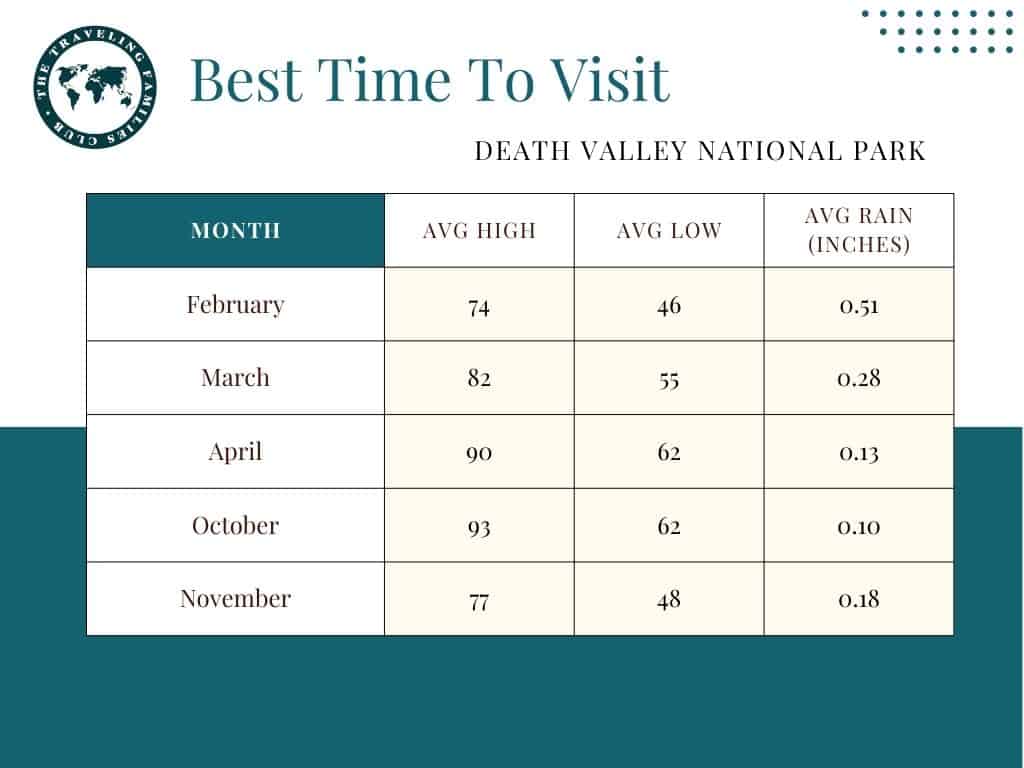
Where To Stay In Death Valley National Park
Hotels
There are three options for hotels within Death Valley;
➡️ Stovepipe Wells Village: Offers resort accommodations as well as limited RV camping with full hookups.
➡️ Oasis at Death Valley: Offers two separate facilities. The Inn at Death Valley is a luxurious high-end hotel. The Ranch at Death Valley is a newly remodeled 275-room hotel built on the site of a once-working ranch and has kept the western theme throughout the property.
➡️ Panamint Springs Resort: This privately run resort offers resort accommodations as well as camping.
Camping
There are a variety of camping options in Death Valley, public campgrounds, private campgrounds, and primitive campgrounds. You can find a complete list of camping options here.
For beginners, we recommend staying in an established public or private campground. These facilities will offer, at a minimum, picnic tables, fire rings, and toilets of some sort. Some will even offer hot showers and a camp store with basic necessities.
➡️ Furnace Creek Campground is a great option due to its central location and ease of access to many of the park’s main attractions.
7. Lassen Volcanic National Park
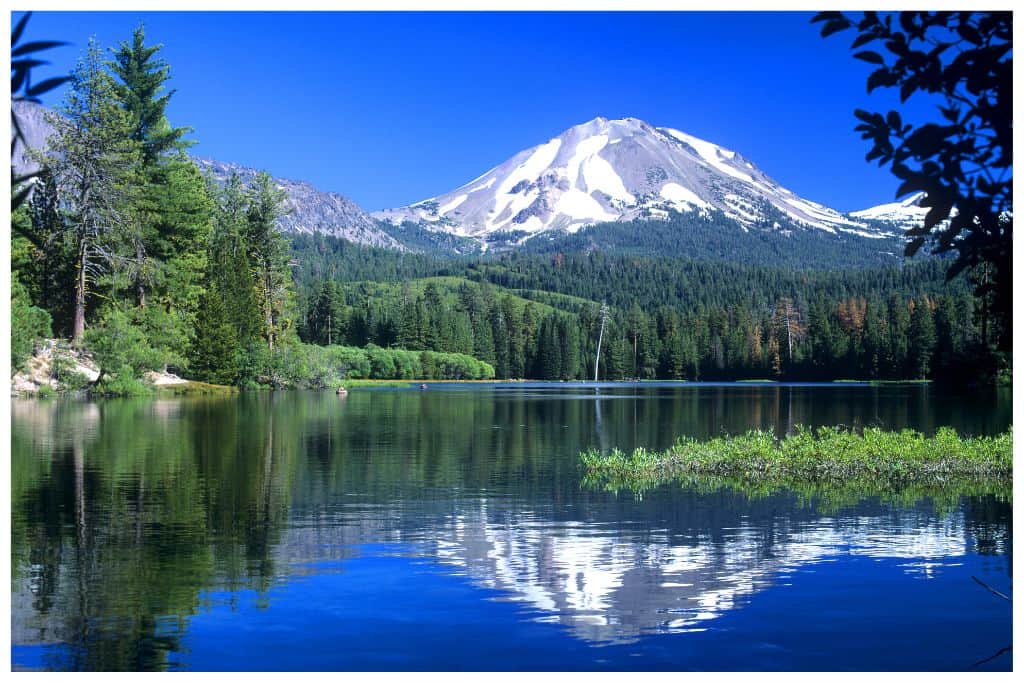
What Is Lassen Volcanic National Park Known For?
Located in North Eastern California Lassen Volcanic National Park is home to a dormant Volcano that erupted as recently as 1915. In addition to the beauty of high alpine forests and crystal clear lakes, the park is home to a variety of volcanic and geothermal features that will make your imagination run.
Lassen is both relatively small and uncrowded, receiving only 500,000 yearly visitors compared to Yosemite’s 5 million.
Unfortunately, a significant portion of Lassen National Volcanic Park was burned in the Dixie Fire of 2021. Thankfully the majority of the park was back open for the summer of 2022. Witnessing the complete devastation is a powerful lesson on the impact of forest fires.
5 Great Things To Do With Kids In Lassen Volcanic National Park
- Bumpass Hell Hike: With its captivating, steaming hot springs and treacherous bubbling mud pots, Bumpass Hell is a must-see when visiting Lassen Volcanic National Park. The trail is relatively short at 3 miles but includes 400 feet of elevation gain and loss.
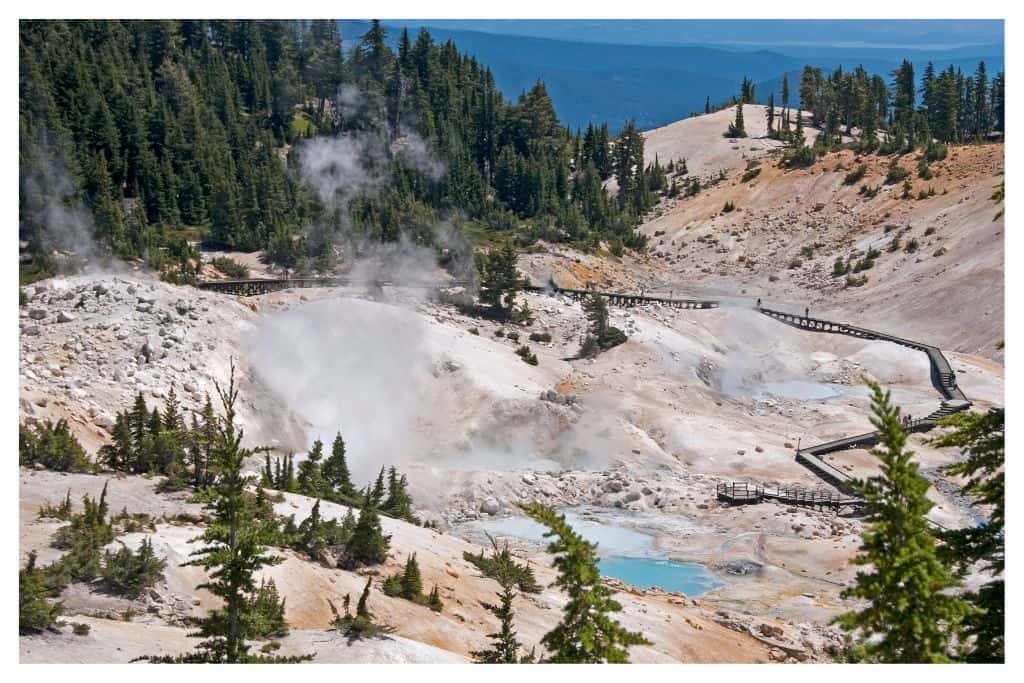
- Manzanita Lake Trail: Hike around this crystal clear turquoise mountain lake. It is an easy walk of only 1.7 miles with stunning views of the lake and the jagged slopes of Chaos Craggs and Lassen Peak in the background.
- Get Lost In The Stars: Lassen National Park is excellent for star gazing. The most significant nearby city, Redding, is 45 miles away so the night skies have very little light pollution. Turn off the lights and watch the Milky Way come alive.
- Subway Cave Lava Tubes: Approximately 20 minutes north of the park the subway cave lava tubes are a ca n’t-miss day trip for families. A self-guided tour will lead you through these hollow lava tubes. Be sure to bring a flashlight as it is pitch black inside the caves.
- Burney Falls: Head another 20 minutes north of the Subway Caves to check out the magnificent Burney Falls. The 130-foot tall falls features multiple cascades all coming together into a beautiful blue pool.
Best Time To Visit Lassen Volcanic National Park
Due to the annual snowfall, the roads to Lassen are only open from June to October. You will find the best weather during late summer from July to September.
Average daytime temps are in the high 70s in July dropping to the mid and low 70s in August and September. Night-time average temps are in the 40s in July dropping down to the high and mid-30s in August and September.
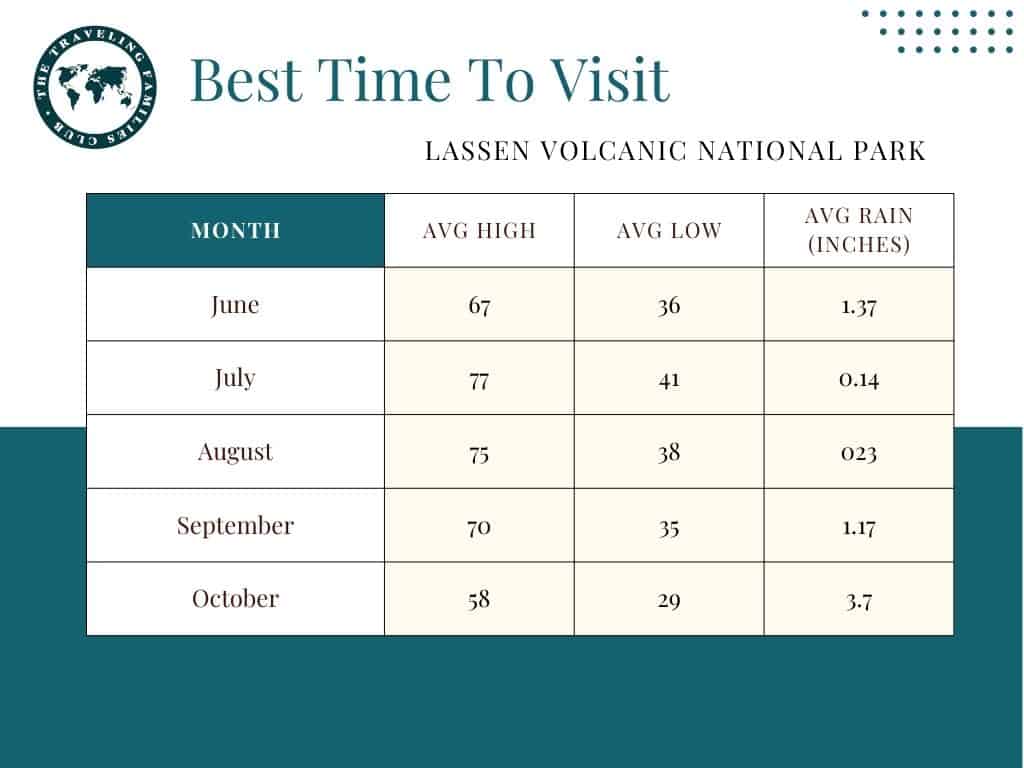
Where To Stay In Lassen Volcanic National Park
Hotels
➡️ Drakesbad Guest Ranch: This is the only hotel within the park. Although it is roughly an hour and a half drive from the ranch to the main attractions of the park.
Camping
There are eight total campgrounds spread throughout the park. You can find a complete list of available campgrounds here.
➡️ We recommend Manzanita Lake Campground. It has the most picturesque view and the lake itself provides plenty of daytime fun.
The campground has a total of 179 sites. There are no electric hookups, but fresh water and flush toilets are available. With showers available at the nearby camp store.
There are also 20 rustic camping cabins available for reservation.
8. Redwood State and National Parks
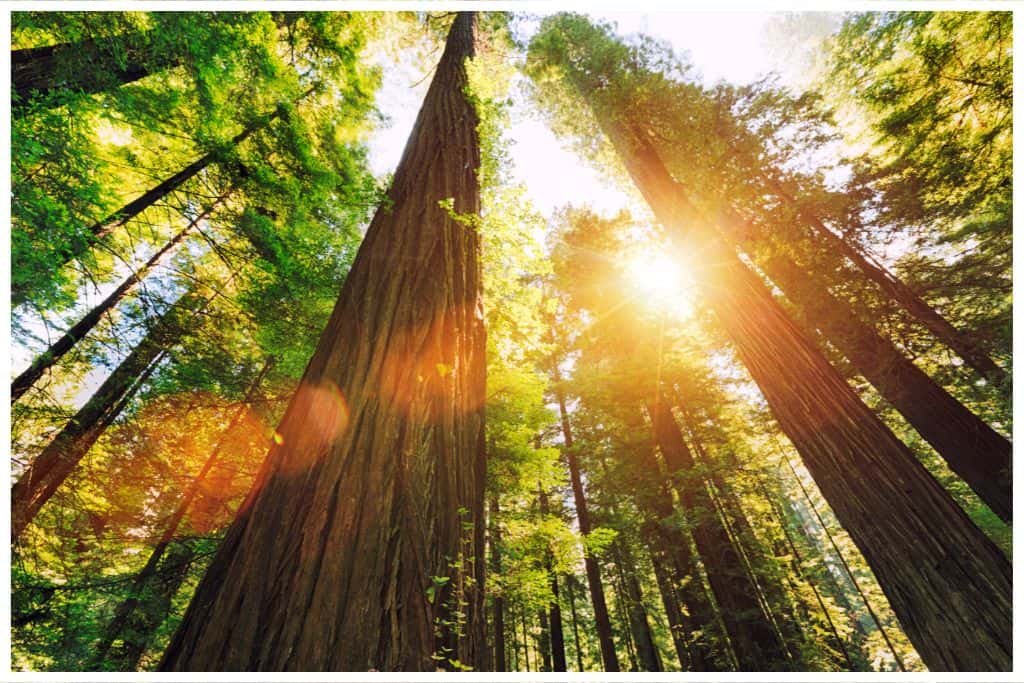
What are Redwood State and National Parks Known For?
Redwood National and State Parks represent an incredible display of nature, featuring ancient-growth forests full of majestic redwood trees and accessible trails to explore.
The massive trees, from which the park gets its name, can sometimes reach heights of over 370 feet— higher than any other tree in the world. In fact, the tallest tree in the world, known as Hyperion, standing an amazing 379 feet tall can be found here.
These towering giants are a captivating part of Redwood National Park, but far from all the natural wonder this park has to offer. Visitors can also gain glimpses into the human history of the area as well as stunning views of the Northern California Coast.
Redwood State and National Parks are unique in that they are a system of 4 parks. Redwood National Park, Jedidiah Smith State Park, Prairie Creek State Park, and Del Norte Coast Redwoods.
5 Great Things To Do With Kids In Redwood State and National Parks
- Stout Grove: Located in Jedidiah Smith State Park, this 44-acre grove is home to numerous 300ft tall trees. This is a short, .7-mile, and flat trail, so it is great for the whole family.
- Fern Canyon: This 1-mile trail wanders up a mini-canyon whose walls are covered in ferns. This area was made famous when it was featured in the film Jurassic Park. While this trail is relatively easy be prepared to get your feet wet as the trail crosses over and through the stream in the canyon.
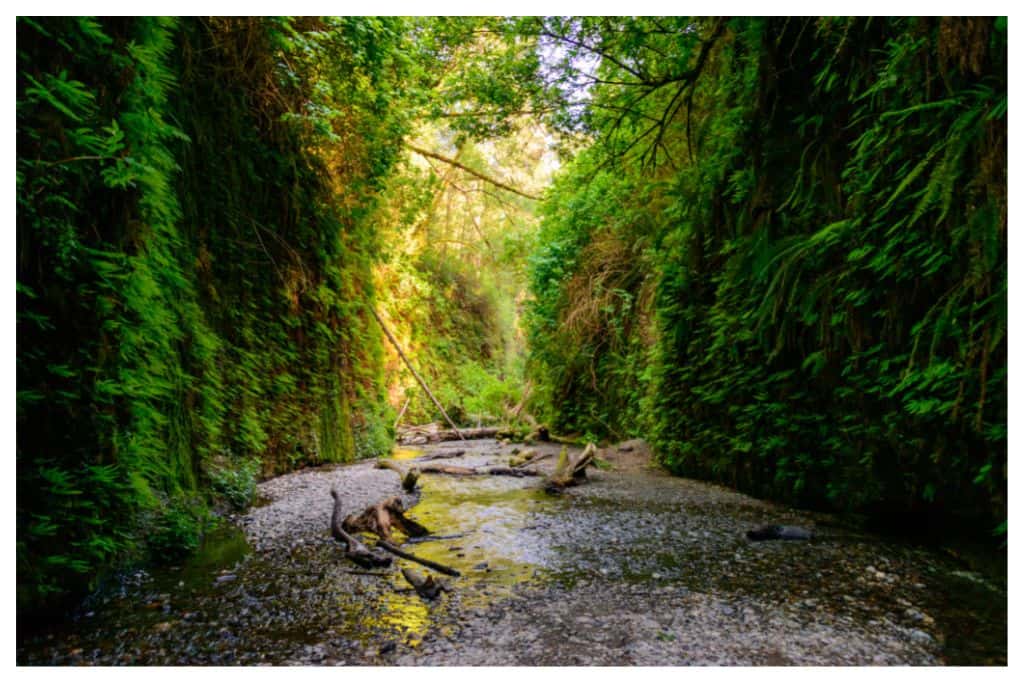
- Drive The Avenue of The Giants: While not technically part of the National Park system this 31-mile stretch of road is worth the drive. Avenue of the Giants passes through the Humboldt Redwoods State Park, home to 17,000 acres of old-growth redwoods, the largest forest of Redwoods left on the planet.
- See The Rosevelt Elk: Roosevelt Elk can be seen in many areas of the park system. In fact, the park is home to seven herds of Elk. The largest, the Bald Hills Herd, often numbers over 250 animals. These majestic animals can be seen anywhere from the forests to the beaches, so keep your eyes peeled!
- Lady Bird Johnson Grove: The Lady Bird Johnson trail is short and flat and great for the kids. This grove is unique in that within minutes you can pass from a second growth to a first growth section of the forest. Giving you a feel for the impact that logging had on these ancient forests.
Best Time To Visit Redwood State and National Parks
Redwood National and State Parks are open year-round. Temperatures are relatively mild throughout the year due to the park’s proximity to the coast. However, it can be rainy in the late fall, winter, and early spring.
The best time to visit is during the late spring through early fall. The park is most crowded during the summer, so if you want to avoid the crowds aim for the spring or fall.
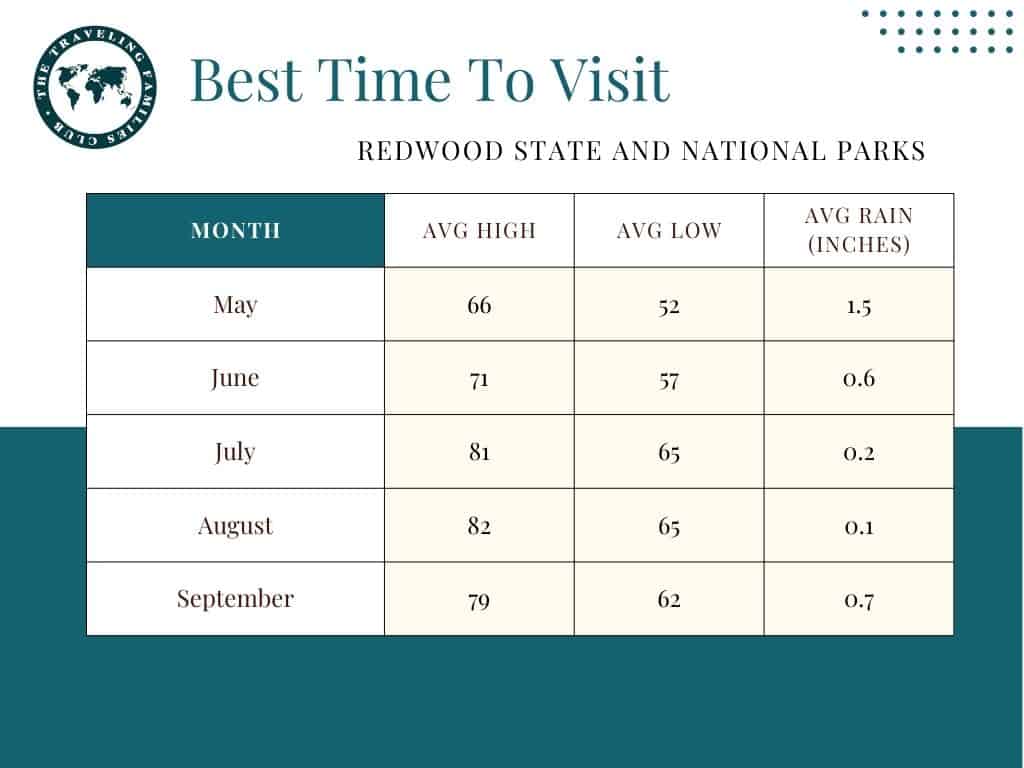
Where To Stay In Redwood State and National Parks
Hotels
There is no lodging available within the park system, however, there are many options for accommodation in the nearby towns, all with easy access to the parks. Nearby towns include Arcata, Trinidad, Klamath, McKinleyville, Eureka, and Crescent City.
Camping
There are four established campgrounds within the park system, all managed by the California State Parks. They are;
➡️ Jedidiah Smith Campground
➡️ Elk Prarie Campground
➡️ Mill Creek Campground
➡️ Gold Bluffs Beach Campground
You can find a full breakdown of what each campground has to offer here.
The Best West Coast National Parks: Oregon
9. Crater Lake National Park
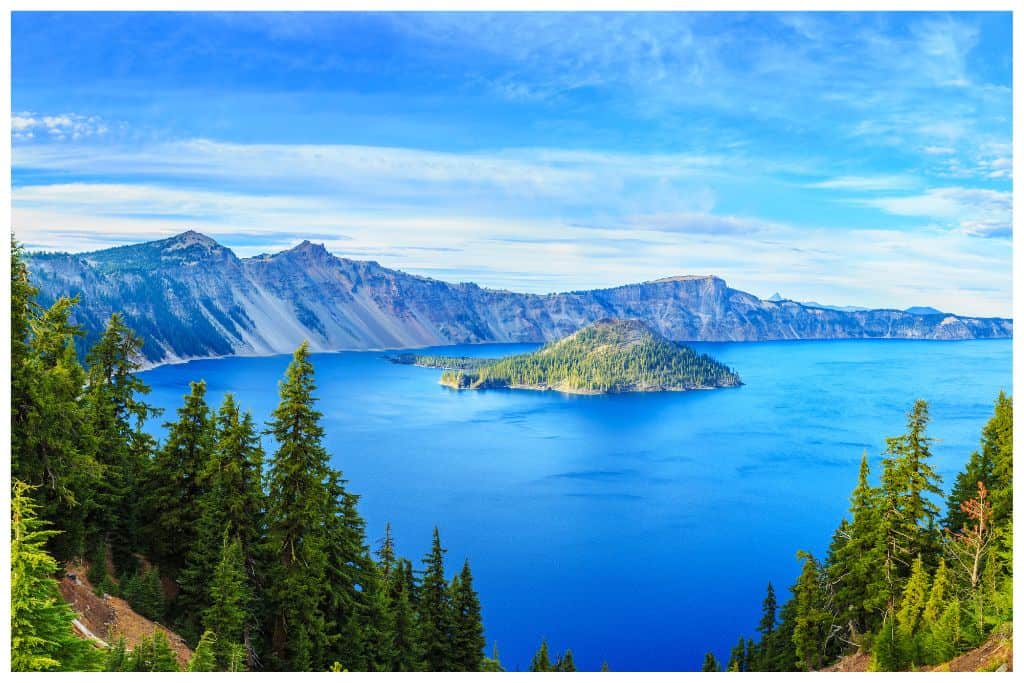
What Is Crater Lake National Park Known For?
For all its natural beauty Oregon is home to only one National Park. Crater lake National Park.
Crater Lake National Park is one of the most breathtakingly beautiful destinations in America, and it’s a must-see for families looking for an unforgettable vacation. Steeped in history and surrounded by diverse wildlife, this park offers something truly special to visitors of all ages.
With its iconic blue lake created centuries ago by a collapsed volcano, Crater Lake National Park provides endless vistas of the stunning scenery that you won’t find anywhere else. At 1,943 feet deep, Crater Lake is the deepest lake in the United States.
5 Great Things To Do With Kids In Crater Lake National Park
- Rim Drive: Crater Lakes Rim Drive is one of the most scenic drives in North America. This 33-mile drive circumnavigates the lake and has countless magnificent vistas. Although it is relatively short, budget a half day for this drive as traffic moves slowly on this windy road, and you will want to stop often.

- Swim in the Lake: To access the lake you will hike the Cleetwood Cove Trail. While the trail is reasonably short at 2 miles, it drops 600 feet over that span, making this a challenging hike. Thankfully, there are many great viewpoints and spots to stop for a rest. Once you reach the bottom you will be rewarded with a magnificent view of the lake and the surrounding crater walls. Cool off by taking a plunge in the icy lake waters.
- Visit the Lodge: The historic Crater Lake Lodge was built in 1915. It sits nearly on the edge of the Caldera and is a staggering 1,000 feet above the water providing an amazing view of the lake. Whether you stay at the lodge, come for a meal in the dining room, or just walk through the lobby, this lodge is well worth a visit.
- Palikni Falls: This easy out-and-back hike leads to a scenic waterfall. The trail is roughly 2 miles long and has 125 feet of elevation gain. This trail is off the beaten path so it can be a good break from the summer crowds.
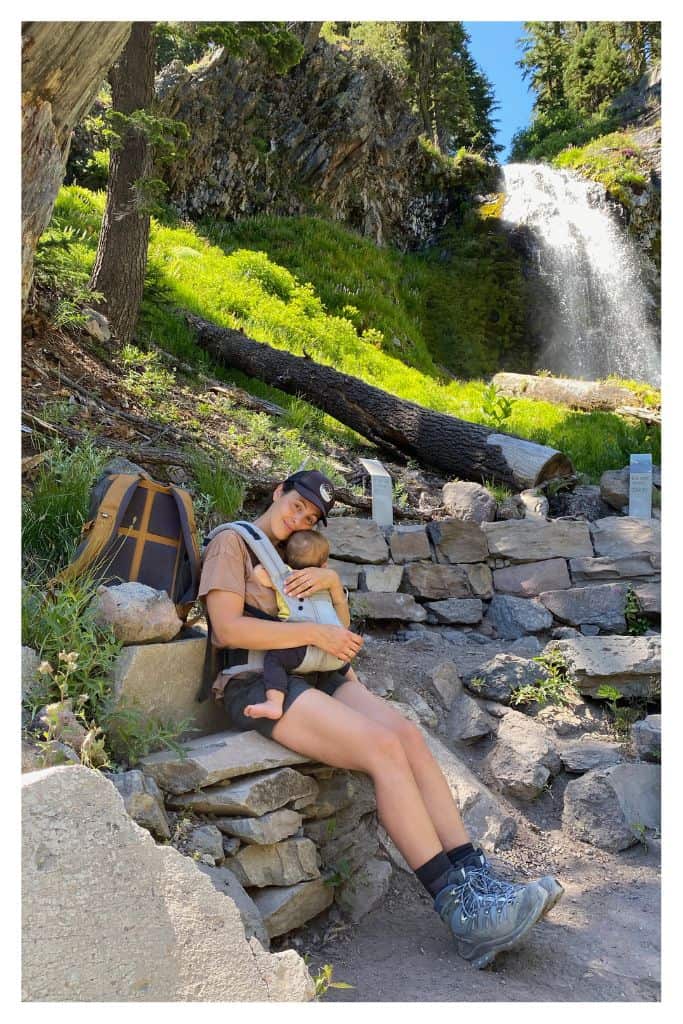
- Watchman Peak Trail: This moderately challenging 1.7-mile trail climbs 400 feet to the Watchman Observation Station. A fire lookout originally built in the early 1930s is now on the National Historic Register. The Watchman Observation Station sits at an elevation of 8,013 feet and provides some of the best views of the lake.
Best Time To Visit Crater Lake National Park
The best time to visit Crater Lake National Park is from July to September. The Park receives heavy snowfall in the winter and portions of the park can remain closed all the way through June.
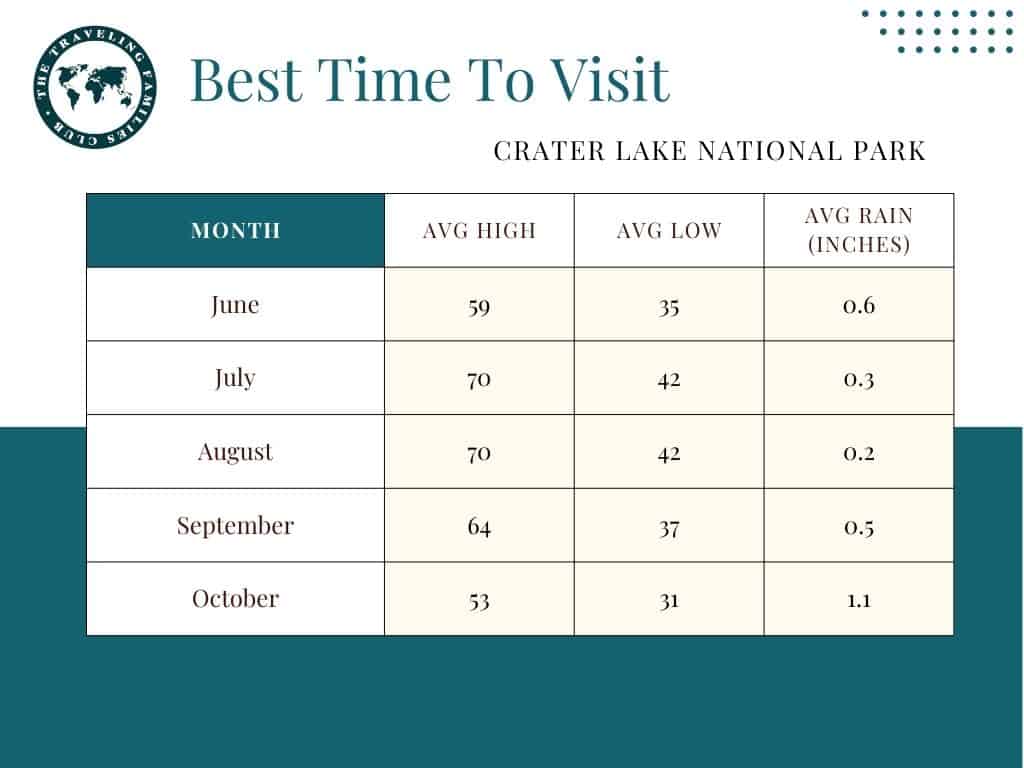
Where To Stay In Crater Lake National Park
Hotels
There are two options for lodging in Crater Lake National Park;
➡️ Crater Lake Lodge: This historic lodge was built in 1915 on the rim of the crater. It offers fantastic views of the lake from many of the rooms as well as the restaurant and bar.
➡️ The Cabins at Mazama Village: Well-equipped cabins that have two queen beds and a private bathroom. The village also offers a restaurant, gift shop, and general store.
Camping
There are two options for camping.
➡️ Mazama Campground: This is a large campground with 214 total sites. Sites contain picnic tables and campfire rings. There is a camp store to purchase ice, souvenirs, and other essentials. There is also a restaurant and gift shop as a part of the Mazama Village, adjacent to the campground.
➡️ Lost Creek Campground: A first come first served, tent-only campground. There are only 16 available sites.
The Best West Coast National Parks: Washington
From the majestic Cascade Range in the west to ancient volcanoes in the east, Washington boasts a wealth of incredible national parks. Washington is home to three national parks in total, two of which made our list of the Best West Coast National Parks For an Epic Family Vacation.
10. Olympic National Park
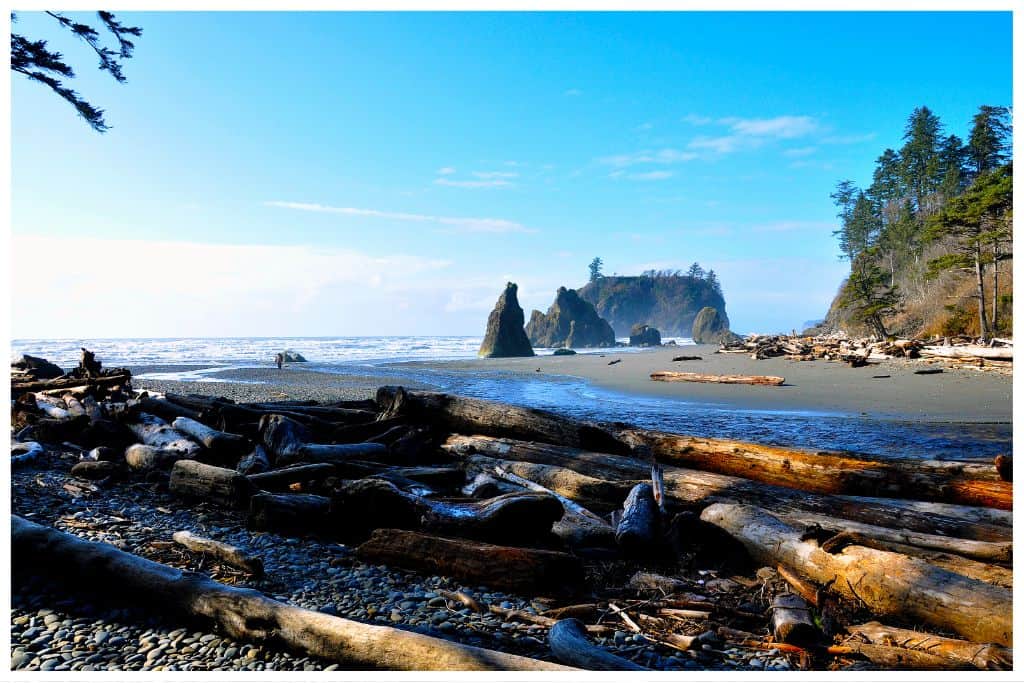
What Is Olympic National Park Known For?
Olympic National Park offers up another stunning natural wonder — this time in the form of rugged mountains and lush rainforests. Located along Washington state’s Pacific coastline,
Olympic is home to several distinct ecosystems including snow-capped mountains, temperate rainforests (with some trees reaching over 500 years old!), alpine meadows full of wildflowers and grasses, and lakes dotted with lily pads — it truly has something for everyone!
Since Olympic is a year-round destination, you can enjoy all its beauty whatever season you visit.
5 Great Things To Do With Kids In Olympic National Park
- Hall Of Mosses: The Hall of Mosses is a short and magical hike through the heart of the Hoh Rainforest. The moss-covered trees, abundant ferns, and variety of beautiful shades of green create the feeling of being in a fantasy land. Though this hike can be crowded it is well worth the visit.
- Go Whale Watching: The waters off of Olympic National Park are home to the apex predators of the sea, Orcas. These incredibly social animals live in pods of up to 40 whales. They hunt in coordinated attacks and are extremely efficient. There are numerous locations throughout the Olympic Peninsula to catch a ride on a whale-watching tour.

- Swim in the Hot Springs: The Sol Duc Hot Springs are centrally located in the park. The Sol Duc Hot Springs Resort features mand-made pools filled with water from the springs. There are a variety of pools and each is temperature controlled by mixing hot and cold water. There are kid-friendly pools as well so bring the whole family.
- Wander the Beaches and Tide Pools: Olympic National Park boasts over 70 miles of coastline. From sandy beaches to rocky outcroppings. Spend a day wandering the beach or marvel at all the creatures in the tide pools. The best tide pools can be found at Kalalochs Beach 4 or Mora’s Hole In The Wall.
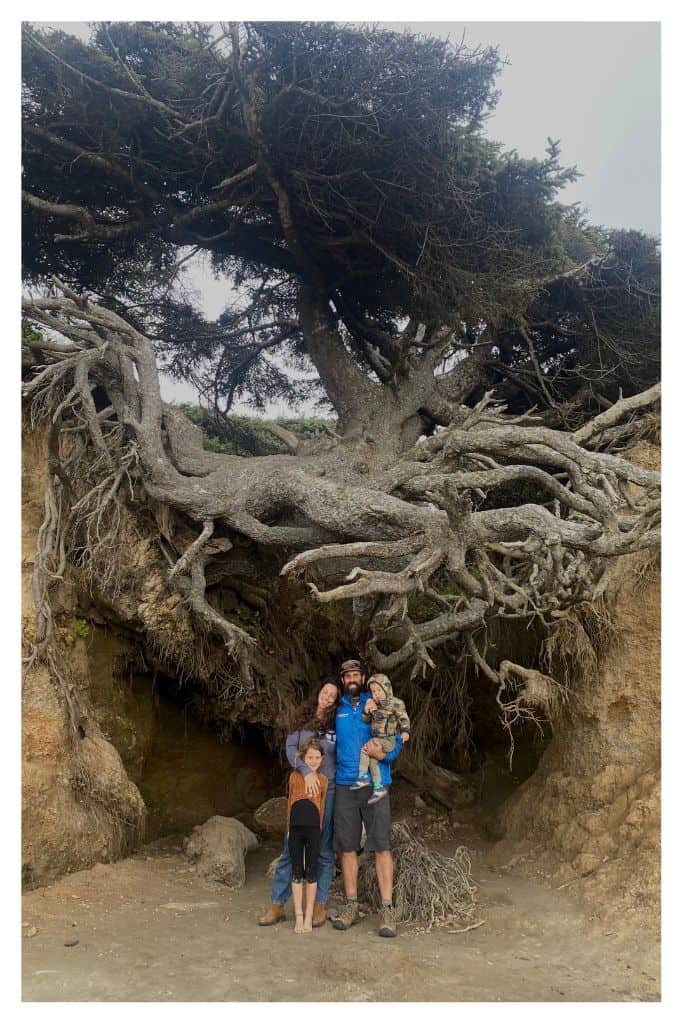
- Hurricane Ridge: Hurricane Ridge is the easiest way to access the mountains in the park. A roughly 45-minute drive up a 17-mile winding mountain road brings you to the Hurricane Ridge visitor center at 5200 feet of elevation. On clear days you will be treated to wide views of the Olympic Mountain Range, including the park’s highest peak, Mt Olympus.
Best Time To Visit Olympic National Park
Olympic National Park is open year-round and each season has something unique to offer. However, the best time to visit is late spring through fall.
The west side of Olympic National Park is the wettest place in the continental United States. The Hoh Rainforest records a staggering average of almost 12 feet of rain per year.
The forests and landscape will be mostly green in the late spring and early summer, but even in the fall, the vegetation remains vibrant.
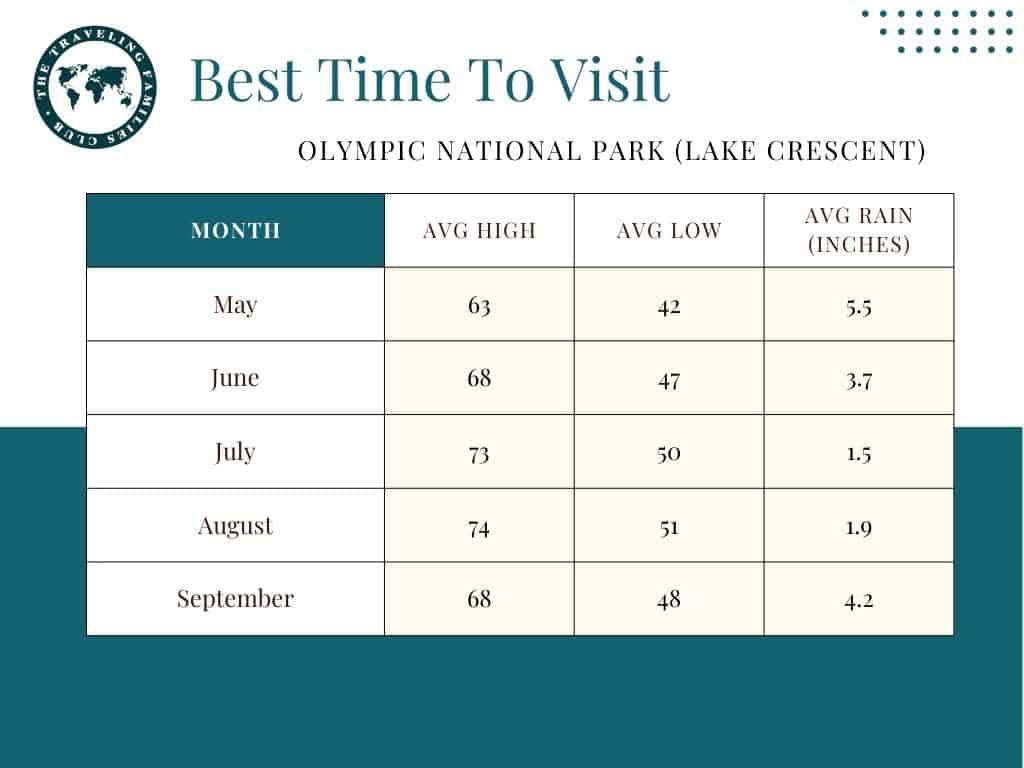
Where to Stay In Olympic National Park
Hotels
There are a variety of lodging options spread throughout the park. From family-friendly cabins to historic lodges built in the early 1900s.
Options Include;
➡️ Kalaloch Lodge
➡️ Lake Crescent Lodge
➡️ Log Cabin Resort
➡️ Sol Duc Hot Springs Resort
Camping
There are a total of 15 different camping options within the park. From beach camping to camping in the rain forest, to high elevation in the mountains. A little bit of everything is available.
You can find a complete list of campgrounds here.
11. Mount Rainier National Park
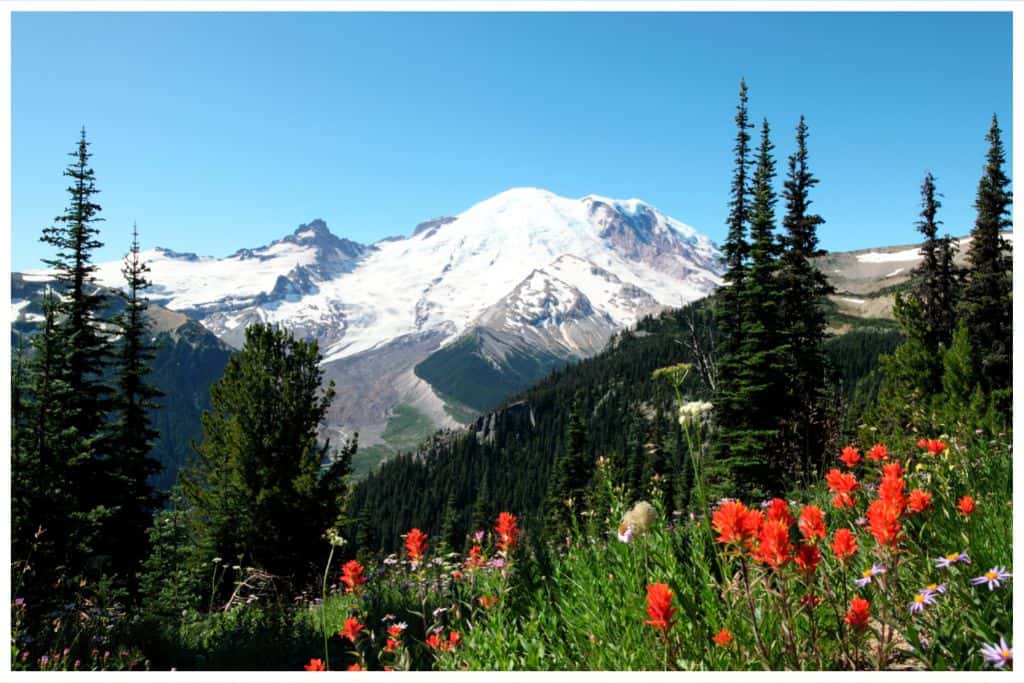
What Is Mount Rainier National Park Known For?
With its towering snow-capped peak, lush forests, meadows full of wildflowers, diverse wildlife inhabitants, and pristine mountain lakes, it is no wonder why this national park has been declared an International Biosphere Reserve.
Whether you’re looking to summit the highest point in the Cascade Range or just take in the fresh alpine air and dramatic views from a scenic viewpoint like Paradise or Sunrise Peak at Mount Rainier National Park, there are plenty of ways to create unforgettable memories with your loved ones as you explore this magical mountain.
Things To Do In Mount Rainier National Park
- Visit Paradise: The Paradise area of Mt Rainier National Park is on the south side of the park and is known for amazing views and fields of summer wildflowers. There are a variety of family-friendly hikes in the area as well as guided ranger programs starting at the Henry M Jackson Memorial Visitor Center.
- Sunrise Point: Sunrise is the highest point in the park accessible by car at 6,400 feet. On a clear summer day, you will be treated to nearly 360-degree views of the park and surrounding mountains. Including a magnificent view of the summit of Mt Rainier and the Emmons Glaciers.
- Visit The Waterfalls: Mt Rainier abounds with amazing waterfalls. Some of the most notable are;
- Narada Falls: Located in the Paradise area Narada falls is the largest waterfall accessible by car. It is just a short walk from the parking area to the viewing area where you will have a few of this 168-foot-tall waterfall.
- Myrtle Falls: Also in the Paradise area and easily accessible by car, Myrtle Falls is 68 feet tall and is notable for having the summit of Mt Rainier as its backdrop.
- Christine Falls: Christine Falls is located in the Longmire region of the park. This 60-foot-tall waterfall is easily accessed within a short walk from the parking location and is framed by a historic arched bridge.
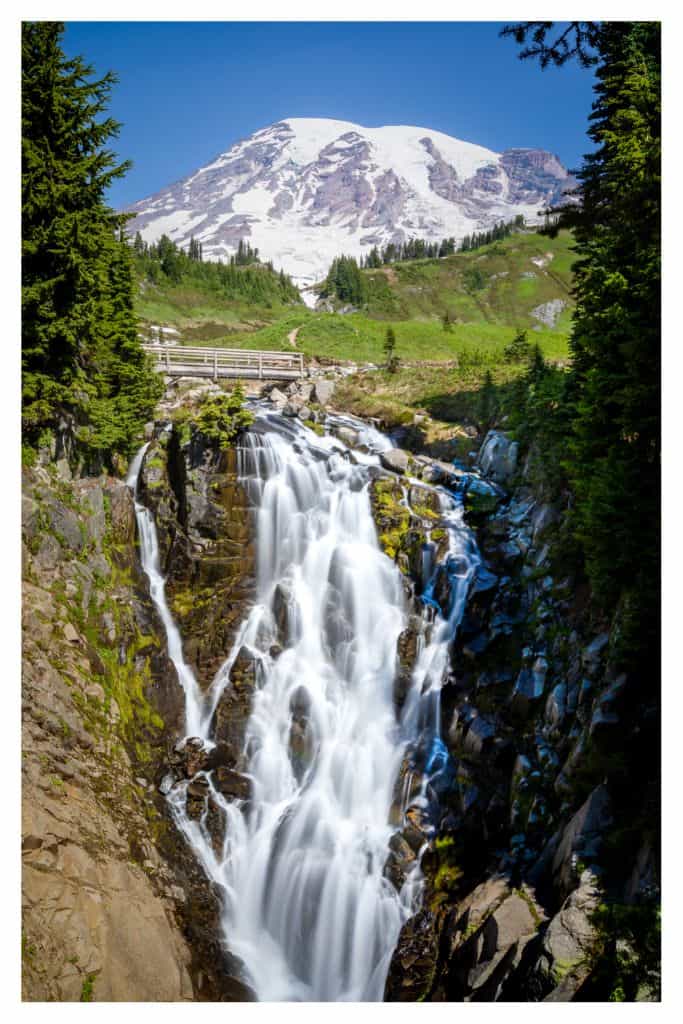
- Ride the Gondola: Just outside the Park the Crystal Moutain Resort offers a scenic Gondola ride that climbs 2,400 feet during a 10min ride. The Summit House restaurant located at the top of the Gondola has the claim to fame of being Washington’s highest restaurant.
- Visit The Longmire Historic District: The Longmire area of the park first served as the homestead of James Longmire before becoming the location of the Park headquarters when Mt Rainier was declared a National Park in 1899. The original Park Headquarters, built in 1916, is now home to a museum that tells of the history of Mt Rainier National Park.
Best Time To Visit Mount Rainier National Park
Mt Rainier experiences heavy snowfall in the winter that forces many of the roads and trails of the park to close until the snow melts in the summer. For this reason, the best time to visit the park is during the summer and early fall. July and August in particular are ideal times to visit. There is still enough water for the waterfalls to be at full flow and the wildflowers to bloom.
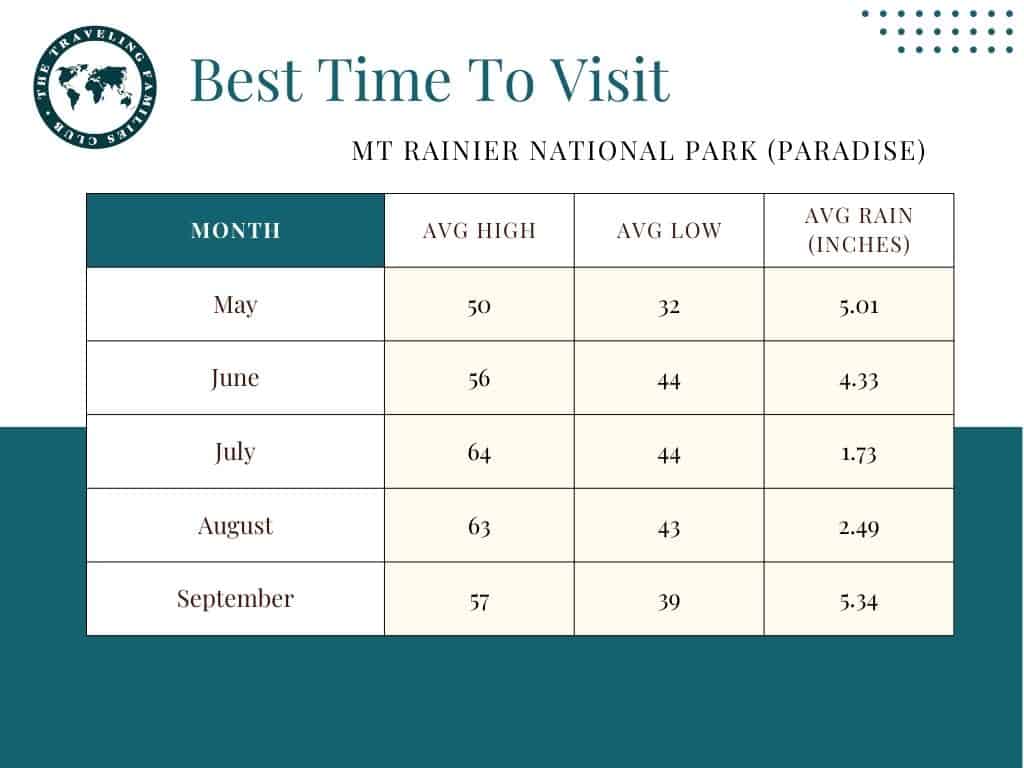
Where To Stay In Mount Rainier National Park
Hotels
There are two inns located within the park.
➡️ National Park Inn: Located in the Longmire District
➡️ Historic Paradise Inn: Built-in 1916 and located in the Paradise District.
Camping
There are three main campgrounds in the park. Cougar Rock and Ohanapecosh are both located on the south side of the park while White River is located in the north.
All the campgrounds are open seasonally depending on snowfall so be sure to check conditions before your trip.
Section 2
The Best Of The Rest In The West
We hope you have enjoyed section 1 covering the Top 11 of The Best West Coast National Parks. While we chose the above 11 for our top destinations there are a total of 12 more national parks on the west coast if you include Alaska and Hawai’i. Alaska alone has 8!
Each of these parks has something amazing to offer, and each one can serve as a fantastic ground for your family exploration.
California
12. Channel Islands National Park
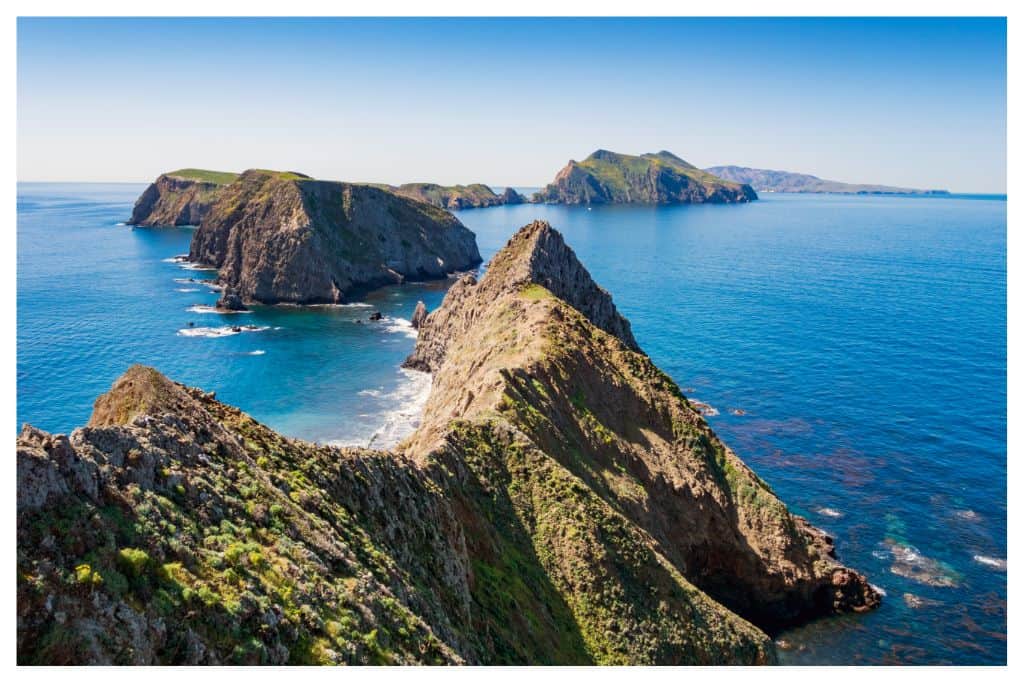
Channel Islands National Park consists of five islands off the coast of Southern California—Santa Cruz Island, Santa Rosa Island, San Miguel Island, Santa Barbara Island, and Anacapa Island.
These islands are home to many rare species of plants and animals that can only be found in this area. The scenery is also spectacular with its sandy beaches, rocky cliffs, crystal-clear waters, lush forests, and grasslands. It’s the perfect place for families to explore together.
In addition to its natural beauty, Channel Islands National Park also holds significance as a cultural site with its archaeological sites that span thousands of years dating back to the Chumash people who first inhabited these lands thousands of years ago.
Washington
13. North Cascades National Park
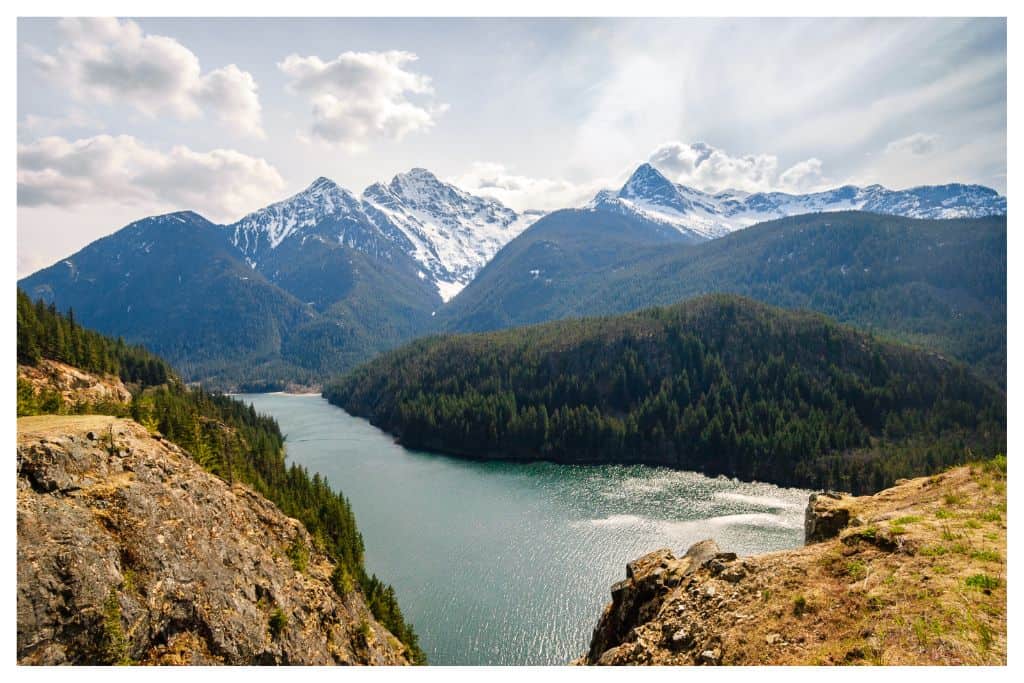
Located in Northern Washington State just a three hours drive from Seattle North Cascades National Park covers more than 500,000 acres. However, it is one of the least visited National Parks in the country. According to the National Park Service, North Cascades National Park was the 4th least visited National Park in 2021 with only 18,000 visitors.
While North Cascades may not receive as many visitors as some of its fellow national parks it is not for a lack of beauty. The park is filled with snow-capped mountains, cascading waterfalls, rugged glaciers, serene lakes, lush forests, and seemingly endless meadows.
North Cascades is home to more than 300 glaciers, more than anywhere in the United States outside of Alaska. The park is also home to over 300 lakes.
The best time to visit North Cascades National Park is from Late June through Late September. The park receives heavy snowfall so many areas won’t be accessible earlier in the year. All but the highest areas of the park are typically free of snow by mid-July.
Alaska
14. Denali National Park
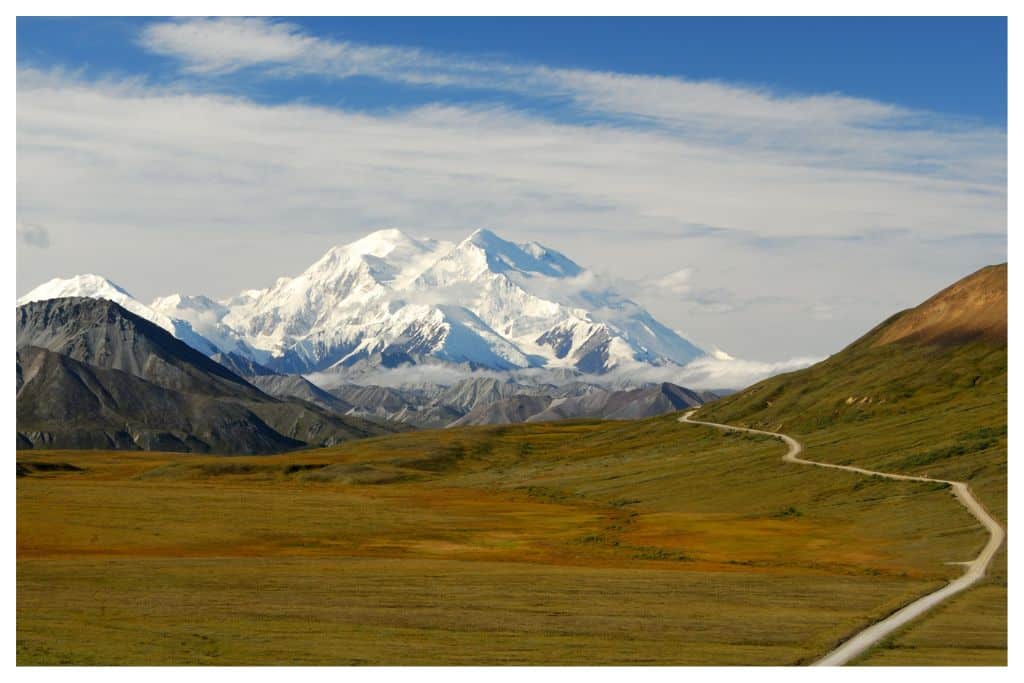
With its snow-capped peaks and lush, green valleys, Mt. Denali National Park is a true wonder of nature. Located in Alaska, the park covers over 6 million acres and includes Mt. Denali—the tallest mountain in North America at 20,310 feet above sea level. Whether you’re an outdoor enthusiast or just looking for a fun and unique family vacation spot, Mt. Denali National Park has something to offer everyone.
In addition to its famed namesake, Mt Denali National Park is known for the abundance of wildlife that calls it home. You can find caribou, grizzly bears, moose, and wolves, among many other animals.
Mt. Denali National Park boasts more than 500 miles (800 kilometers) of trails for visitors to explore, ranging from beginner-friendly walks along riversides and through meadows full of wildflowers to more challenging treks into the wilderness with views of stunning mountain peaks in every direction. The terrain varies greatly throughout the park, so there’s something here for everyone regardless of their skill level or physical fitness level—just make sure you come prepared with proper gear and clothing before heading out into the wild!
15. Gates Of The Arctic National Park
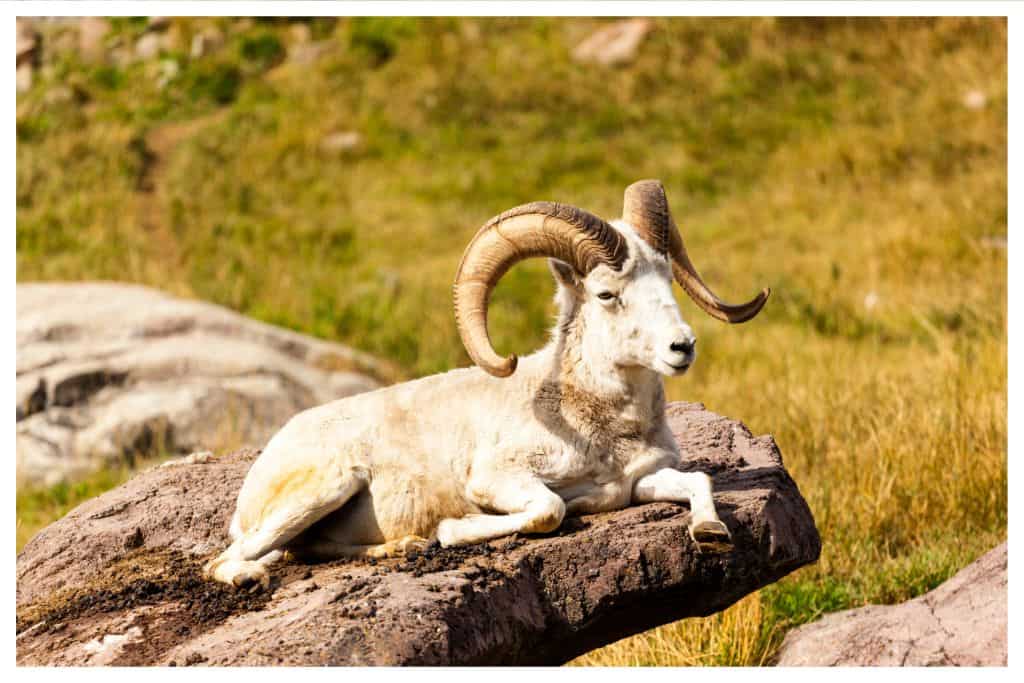
Gates of the Arctic National Park is one of the most remote and wild national parks. Covering 8.5 million acres it is the second-largest national park in the United States. However, this vast wilderness does not have any roads or trails, making it genuinely wild.
With its remote location, lack of tourist infrastructure, and harsh climate, it is no wonder that Gates of The Arctic is the least visited National park in the country. According to the National Park Service, it received just over 7,000 visitors in 2021.
Given the challenging conditions Gates Of The Arctic is home to a surprisingly wide variety of wildlife. Among the parks, inhabitants are; caribou, brown bear, wolves, Dall sheep, lynx, beavers, musk ox, and many more.
16. Glacier Bay National Park
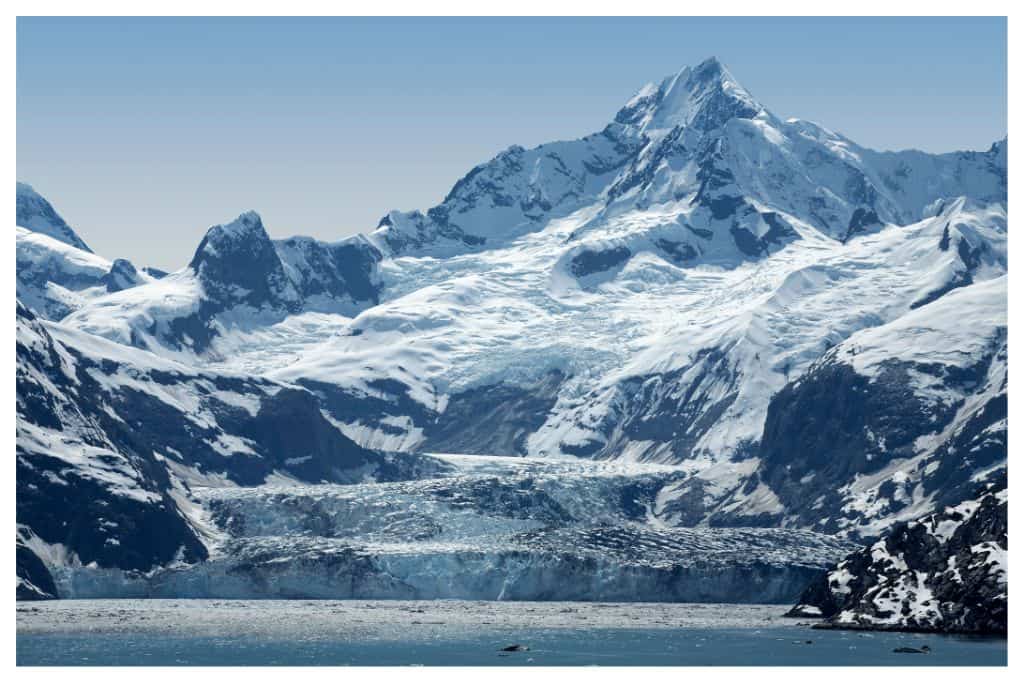
Glacier Bay is home to some of the most spectacular sights in Alaska. The park features over 1,000 glaciers! The majority of these lay high in the mountains, but a few reach all the way to the ocean.
Marjorie Glacier is particularly impressive; it stretches out over 4 miles long and is one of the most picturesque spots in the entire park.
Glacier Bay National Park covers over 3.3 million acres. It is located in southeast Alaska and is considered one of the highlights of Alaska’s inside passage. The park can only be reached by boat or by plane and is often visited by passengers on cruise ships.
The view of the jagged almost-blue glaciers pushing into the sea with the mountains rising dramatically in the background is truly an impressive sight.
17. Katmai National Park
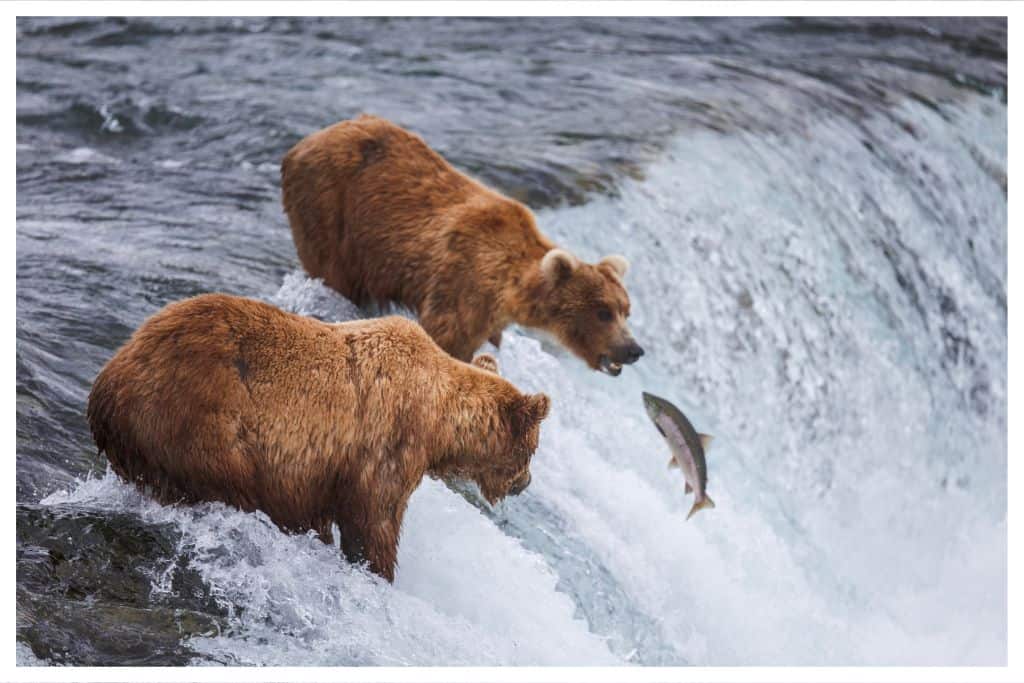
Designated as a national park in 1918 Katmai is home to the largest volcanic eruption in the 20th century. In 1912 Novarupta expelled over 15 cubic kilometers of magma over a 60-hour period.
Today the park is perhaps most well-known for being home to thousands of brown bears. Scenes from the park are often featured in nature documentaries and photographs.
In particular, the Brooks Camp draws visitors from around the world to witness brown bears fishing for salmon in the Brooks River.
Katmai is the location of a vital spawning ground for Bristol Bay Sockeye Salmon. The fish help to sustain the large bear population.
18. Kenai Fjords National Park
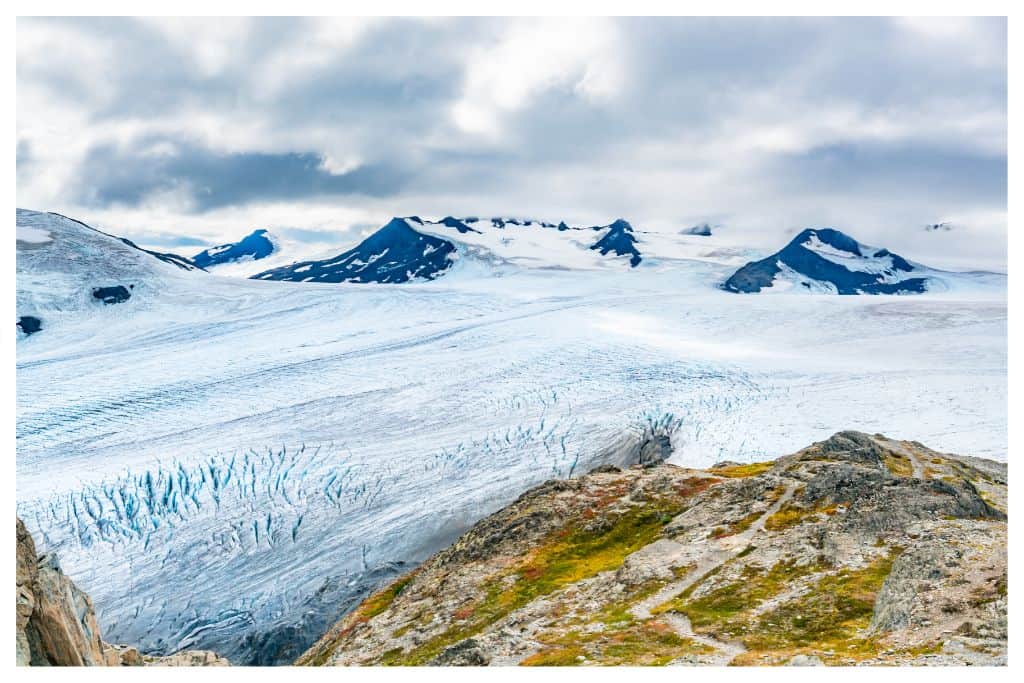
Kenai Fjords National Park is located on the edge of the Kenai Peninsula in southern Alaska. The park is dominated by ice, approximately 50% of it is covered by ice.
The most notable feature of the park is the Harding Icefield. A 700-square-mile expanse of ice that dates back 23,000 years. The Harding Icefield is thousands of feet thick and connects over 30 glaciers, all flowing outward from the icefield.
One of the unique aspects of the Harding Icefield is its relatively easy accessibility. Kenai Fjords National Park is located just outside the town of Seward Alaska, which is only 127 miles from Anchorage. Once in the park, the Harding Icefield can be accessed on a short, but steep 4-mile hike starting at the Exit Glacier Ranger Station.
19. Kobuk Valley National Park
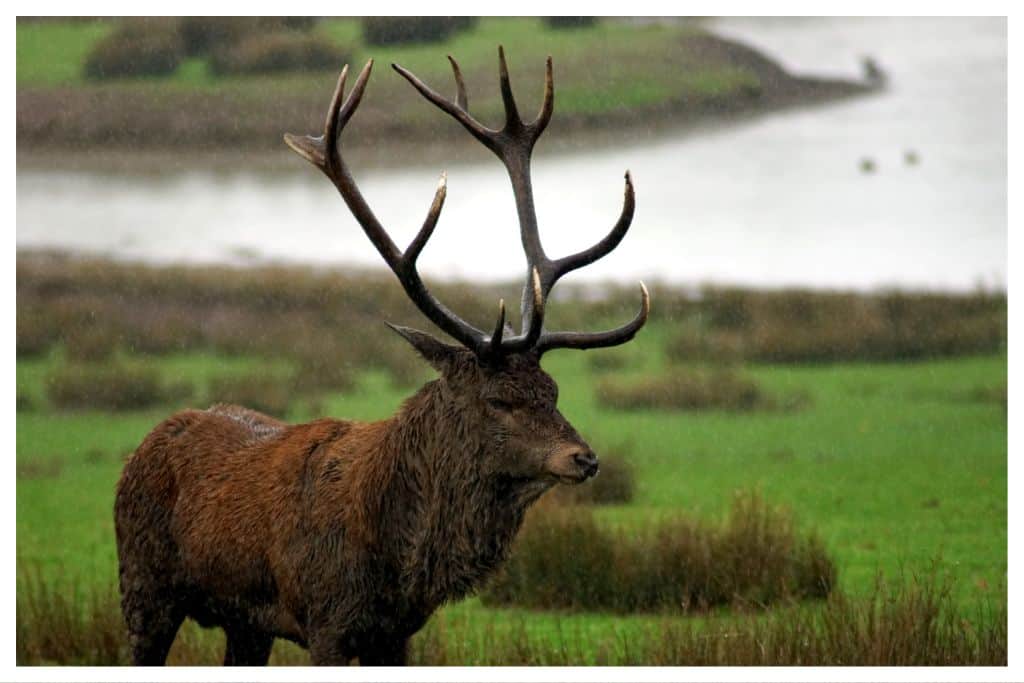
Sand dunes and Alaska are probably not two things you associate, but within Kobuk Valley National Park in northwestern Alaska lay the Great Kobuk Sand Dunes, a 25-square-mile patch of dunes that rise over 100 feet tall.
However, perhaps the most notable aspect of Kobuk Valley National Park is that it has served as a caribou hunting ground for 8,000 years! Every year nearly half a million caribou must cross the Kobuk River during their annual migration. They have been making this crossing at a location called Onion Portage for thousands of years.
There is archaeological evidence that humans have been coming to Onion Portage during the caribou crossing to hunt for at least 8,000 years.
Visiting Kobuk Valley National Park takes a bit more planning than many other parks, as there are no roads, trails, or infrastructure of any kind within the park. It is true Alaskan Wilderness.
20. Lake Clark National Park
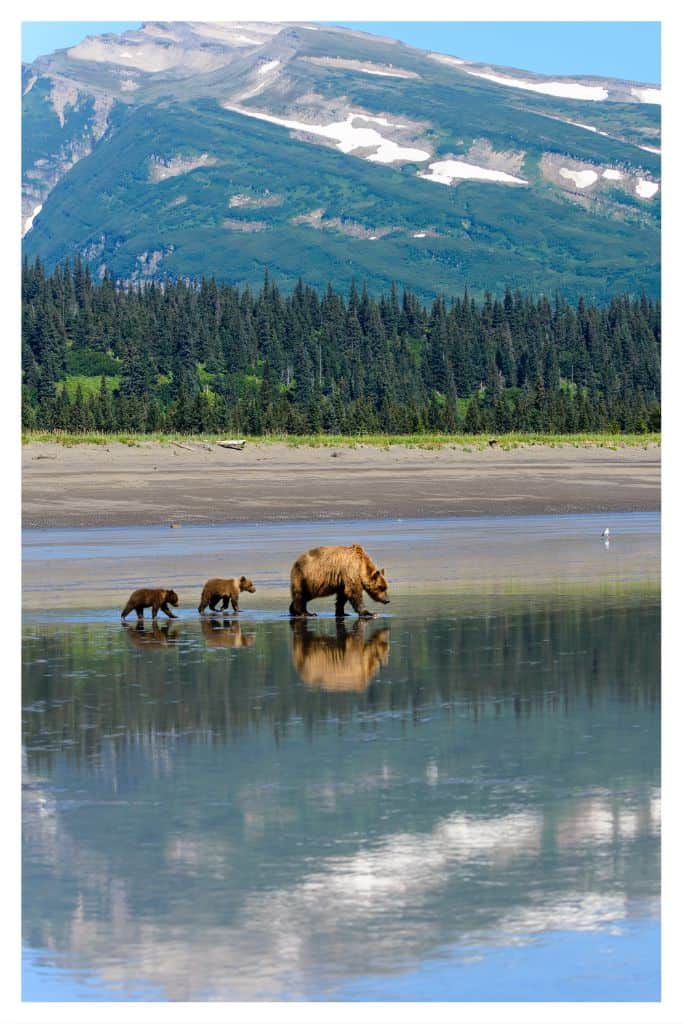
Located in south-central Alaska Lake Clark National Park is a land of dramatic beauty. Steaming Volcanoes, bears feasting on salmon, turquoise glacial lakes, and jagged mountain ridges can all be found in Lake Clark National Park.
Bear viewing is one of the park’s primary draws. The park supports a large population of both brown and black bears which feast on the sockeye salmon whose breeding grounds lay within the park.
There is limited infrastructure within the park. The only established trail system is in Port Alsworth and the park’s most popular destination, Lake Crescent, can only be reached by plane.
Like many of Alaska’s other National Parks Lake Clark is a true wilderness where humans are just the visitors.
21. Wrangell – St. Elias National Park
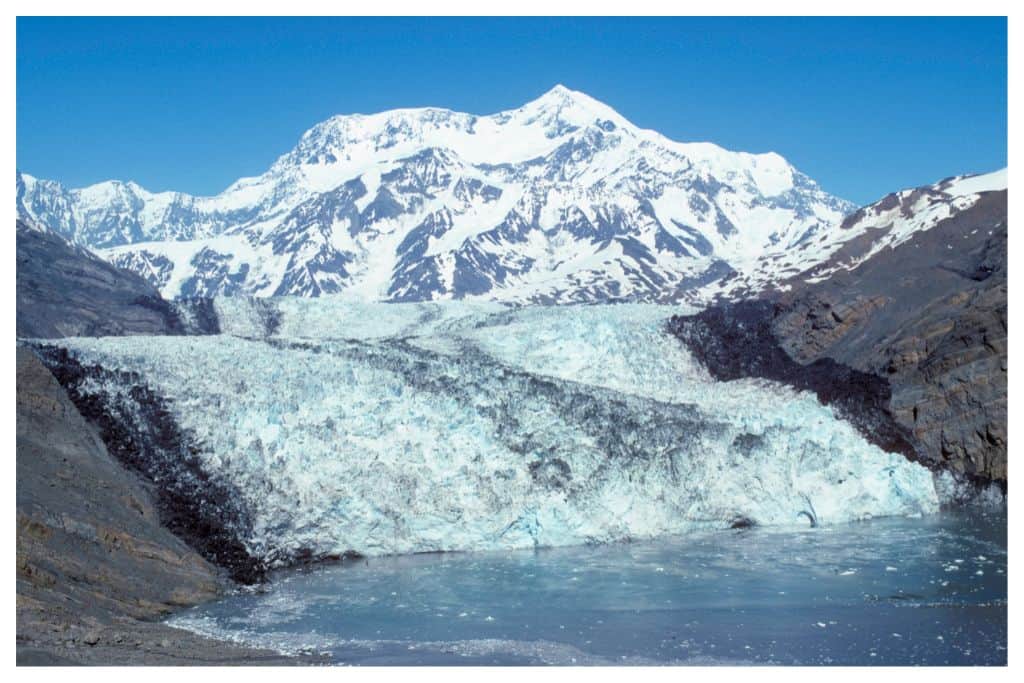
Located in eastern Alaska Wrangell – St. Elias is the largest national park in the United States. In fact, at 15,000 square miles, it is larger than 9 states.
Wrangell – St. Elias has many claims to fame. It is home to the Bagley Icefield, at 127 miles long, 6 miles wide, and 3,000 feet deep, Bagley is the second largest non-polar icefield in North America.
The Hubbard Glacier is the longest tidewater glacier in North America. It is 75 miles long, 7 miles wide, and 600 feet tall at the point it meets the ocean.
The St. Elias range, home to Mt St. Elias, the second tallest peak in the United States at 18,008 feet, is the tallest coastal mountain range in the world.
Similar to other Alaskan National Parks, you won’t find much development in Wrangell-St. Elias. There are only roughly 100 miles of road in the entire park.
Hawai’i
22. Haleakalā National Park
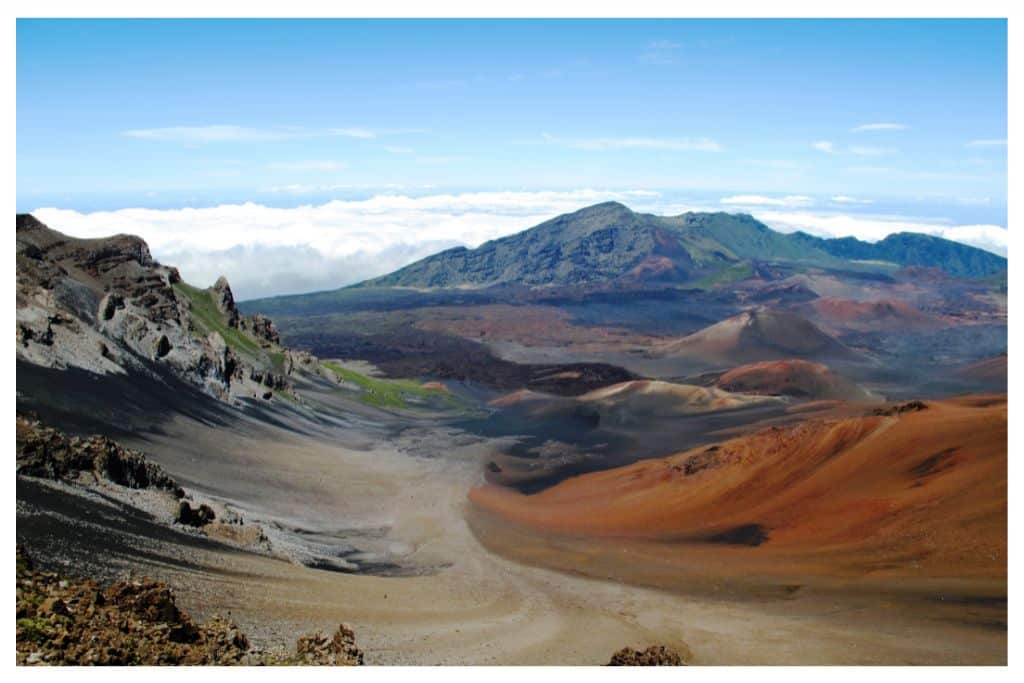
Located on the Hawaiian Island of Maui, Mt Haleakalā stands at 10,023 feet above sea level. However, this mountain doesn’t start at the sea. In fact, this volcanic mountain originates on the ocean floor 19,680 feet below the surface of the ocean.
That means taken from base to summit Mt Haleakalā is 29,703 feet tall. Making it the tallest mountain on the planet when measured in this fashion. From base to summit it is taller even than Mt Everest, which tops out at 29,032 feet.
Haleakalā is very accessible with many opportunities for visitation. There is a parking lot and visitor center as high as 9,740 feet.
However, take note that visiting the summit district of the park does require a permit reserved in advance. These permits are limited and popular, so be sure to apply before your trip.
23. Hawai‘i Volcanoes National Park
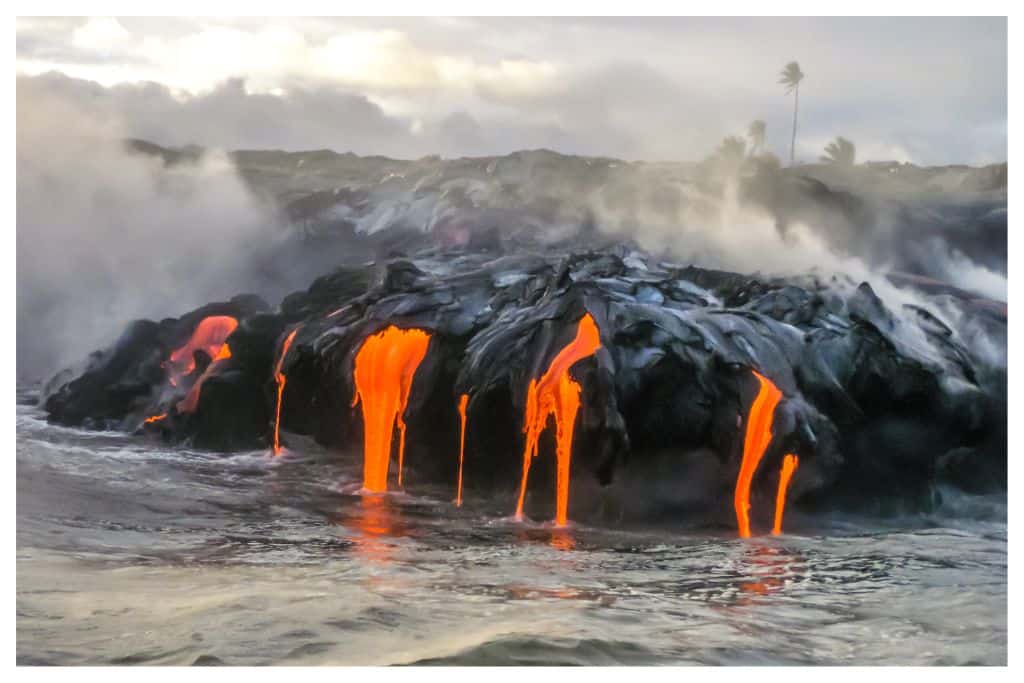
Hawai’i Volcanoes National Park is home to two of the world’s largest active volcanoes, Kilauea and Mana Loa.
The park covers from sea level all the way up to 13,680 feet. There are many opportunities to get up-close views of volcanic activity. You can see the glow of the lava lake inside Halemaʻumaʻu crater. You can tour the inside of empty lava tubes. Scenic drives will take you past vast hardened lava flows. At times it is even possible to see lava flowing into the sea.
These are active volcanoes so at times areas of the park may be closed due to eruptions. Be sure to check on the conditions before visiting the park.
Section 3
Best Of The West (But not quite on the coast) National Parks
This list is focused on the West Coast specifically and as such, we chose only to include parks from California, Oregon, Washington, Alaska, and Hawai’i for consideration.
However, there are many more equally amazing national parks in some of the nearby western states. Below is a list of our favorite parks from the western states that should definitely be on your bucket list!
Montana
24. Glacier National Park
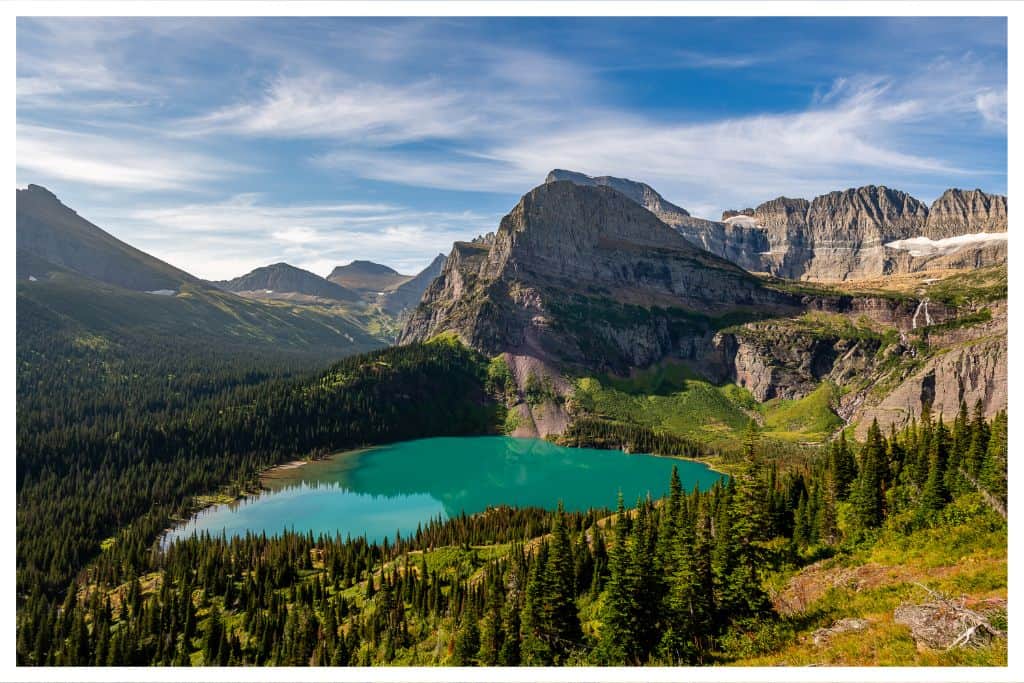
Located in Northern Montana, the park boasts over 1 million acres of breathtaking scenery and abundant wildlife. With hiking trails for all levels and plenty of camping opportunities, it’s easy to spend days exploring all that Glacier National Park has to offer.
Glacier National Park has something for everyone in your family – no matter their age. Older children and adults will love taking on longer hikes, such as the Highline Trail, which takes you along a narrow path high up in the mountainside. Meanwhile, younger kids will appreciate more accessible trails such as the Trail of Cedars, where they can take short strolls while admiring towering trees and rushing streams.
Glacier National Park is brimming with wildlife. You’ll have plenty of chances to spot different types of birds, bears, elk, deer, mountain goats, and much more throughout your time here! Many visitors also take advantage of ranger-led programs that can give you an even deeper understanding of these creatures’ behavior and habits during your visit
Glacier National Park has numerous campgrounds and lodges within the park, however, it is a popular destination so you will still want to plan well ahead to reserve your accommodation.
Wyoming
25. Yellowstone National Park
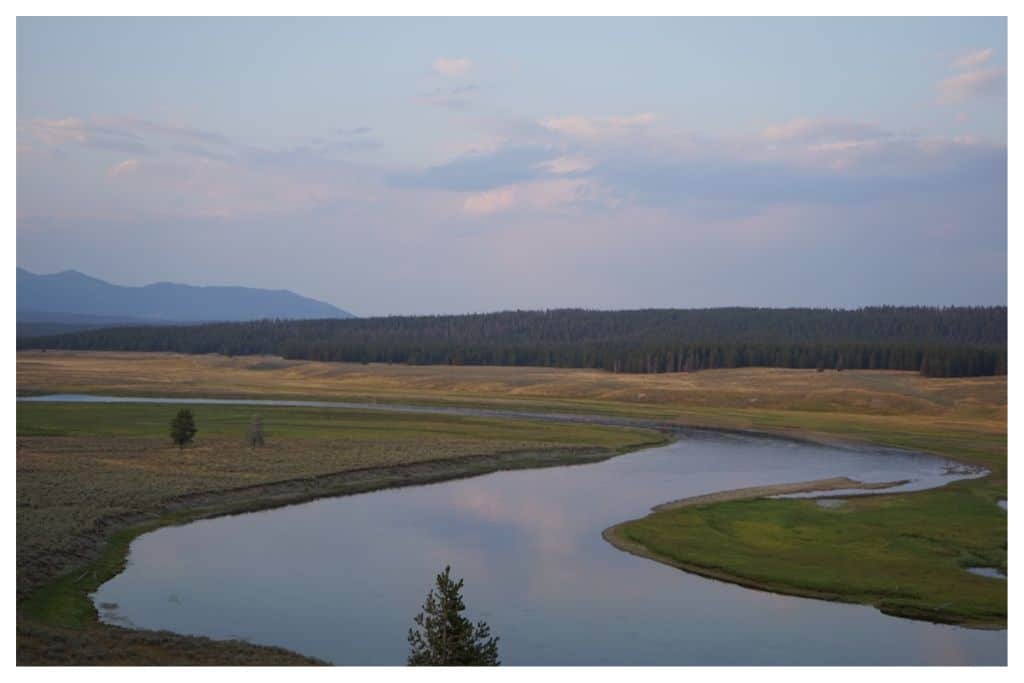
Yellowstone National Park is the Nations oldest and perhaps most impressive national park. Yellowstone is world-renowned for being home to an amazing assortment of wildlife and in particular large mammals. Grizzly Bears, Black Bears, Wolves, Elk, Moose, and Bison are just a few of the animals that call Yellowstone home.
When visiting one of the first things you’ll notice about Yellowstone is its unique terrain. The park sits atop an ancient, active volcano, which means that much of the landscape is dotted with hot springs, mud pots, and geysers.
Old Faithful, of course, is the most famous of these features, but there are plenty more to explore. Watching these features erupt can be both exciting and educational for kids as they learn about geology and nature.
Yellowstone has a great tourist infrastructure, there are many opportunities for ranger-led programs for both adults and children. Horseback rides are available within the park and are a great way to explore.
There are multiple campgrounds and lodges spread throughout the park. However, with close to 4 million annual visitors Yellowstone is one of the nation’s most popular national parks so be sure to plan your visit as far in advance as possible.
26. Grand Tetons National Park
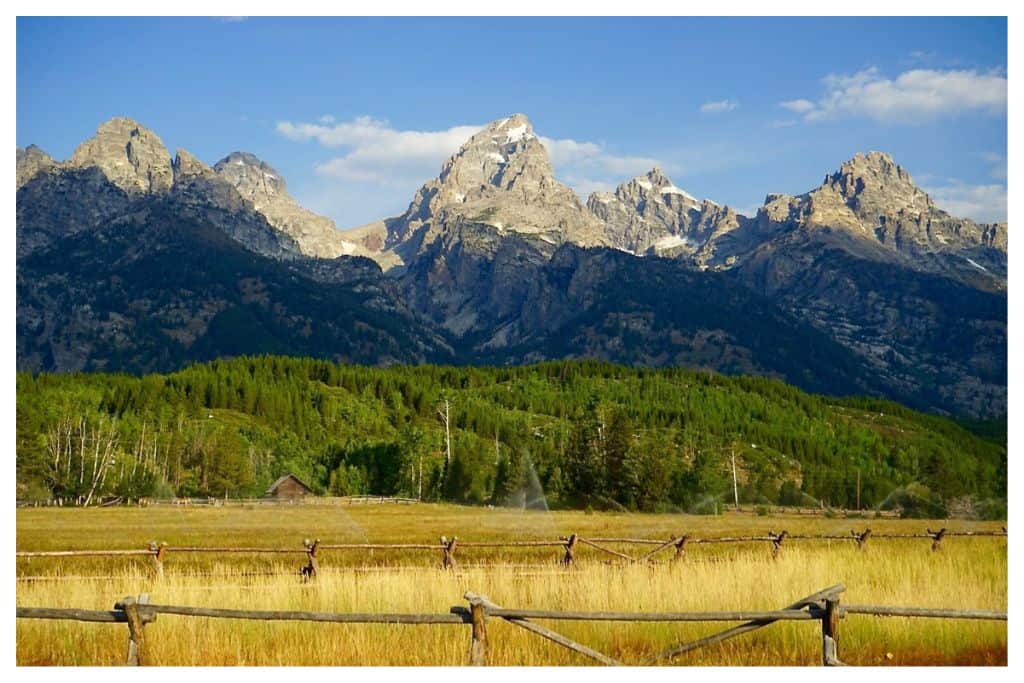
Grand Tetons is located just south of Yellowstone in Wyoming and is most well known for the Teton Mountain Range. Stunning views of the dramatic peaks can be seen throughout the park.
Grand Teton National Park is a photographer’s dream with beautiful winding rivers, crystal clear lakes, and abundant wildlife, all set to the backdrop of the Grand Teton peaks.
The Tetons are a great family destination, with over 200 miles of hiking trails spread throughout the park there are hikes of all levels. The most experienced hikers can choose to summit the Tetons, while families with young kids can enjoy easy strolls along rivers or through meadows.
Jenny Lake is a great spot for families, take the ferry across the lake and hike up the short trail to Hidden Falls.
Families will love to stop at Dornan’s Chuck Wagon Grill for a meal. An outdoor western-themed grill with fantastic views of the Tetons from their picnic tables.
Lodging is available in the park or in the nearby town of Jackson. Camping is available throughout the park.
Colorado
27. Rocky Mountain National Park
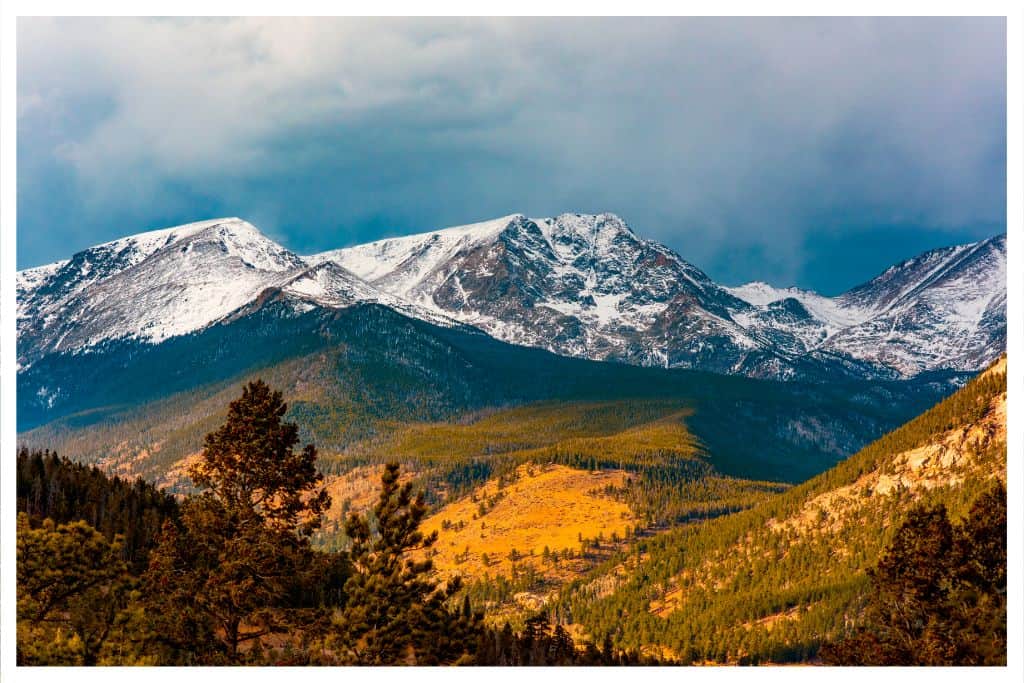
Rocky Mountain National Park is home to more than 415 square miles of breathtaking scenery. The park’s highest peak, Longs Peak, stands at 14,259 feet above sea level and provides spectacular views from the top. There are also over 150 named lakes within the park boundaries and numerous waterfalls that will take your breath away.
Wildlife viewing opportunities are some of the best in the country; elk, bighorn sheep, moose, black bears, coyotes, deer, and beavers all call Rocky Mountain National Park home.
There are over 300 miles of trails within the park system. From difficult trails up to some of the park’s impressive summits to easy trails meandering through mountain meadows, there are hiking opportunities for all levels.
Rocky Mountain National Park has five established campgrounds but no hotels or lodges within the park. There is lodging available in the nearby towns of Grand Lake and Estes Park.
Utah
28. Arches National Park
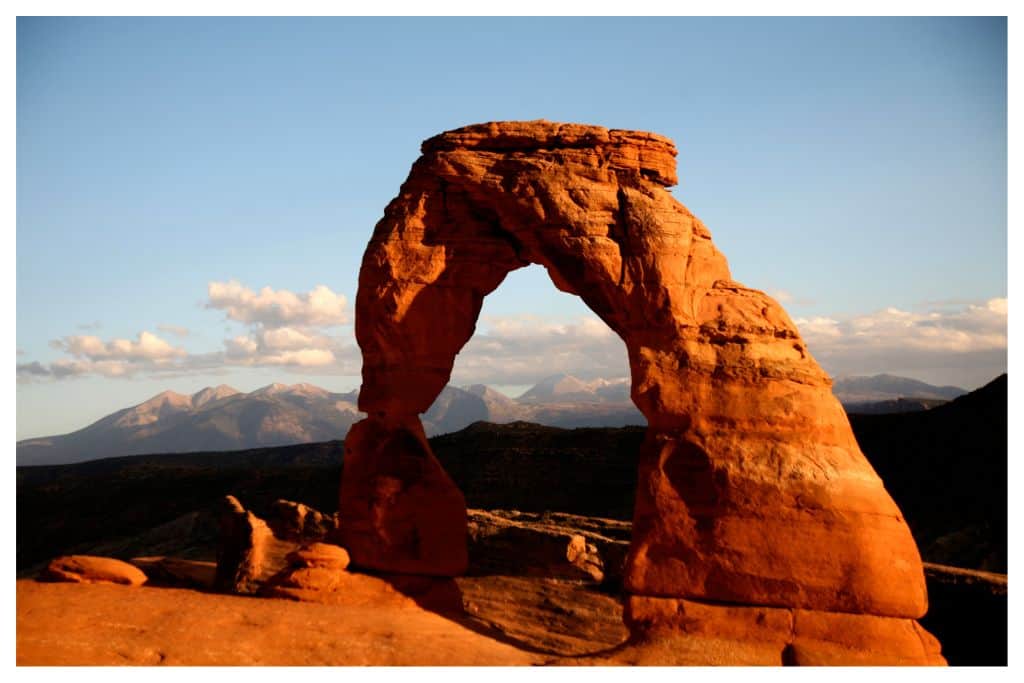
Located in southeastern Utah, Arches National Park is a stunningly beautiful area filled with giant sandstone arches, towering red rock formations, and plenty of opportunities for exploration and adventure. If you’re planning on visiting the park with your family, here are some of the best things to do.
Arches National Park offers over 20 different trails that range from easy to strenuous. While there are some trails that are suitable for small children, many of them require a bit more stamina and endurance due to their length and terrain. For those who prefer biking to hiking, there are several bike-friendly trails that wind throughout the park. Be sure to bring plenty of water and wear sunscreen since much of the trail is exposed to direct sunlight.
The only opportunity to stay within Arches is camping at Devils Garden Campground. The campground does offer electric hookups as well as picnic tables and fire rings for campers who want to enjoy a campfire under starry skies. Keep in mind that since space is limited, it’s important to make reservations ahead of time if you plan on camping here during peak season from March through October.
There are many other camping opportunities in the nearby areas as well as lodging in the nearby town of Moab.
29. Canyon Lands National Park
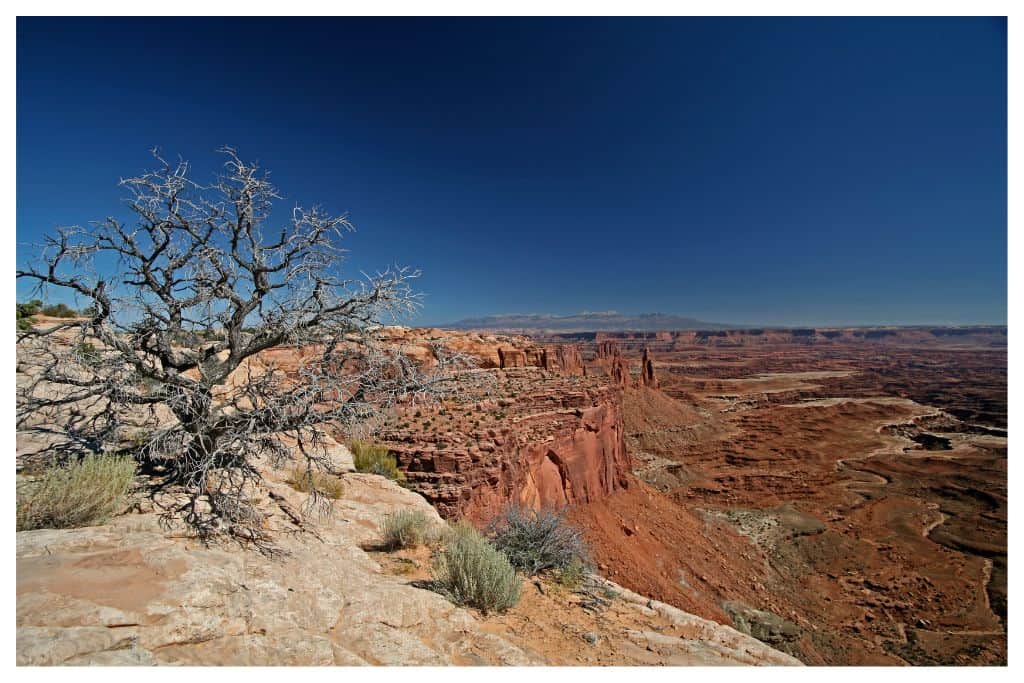
Located in southeastern Utah, not far from Arches National Park, Canyonlands spans across towering mesas and deep canyons carved out by the Colorado and Green Rivers.
Canyonlands is unique in that it is split into three separate districts by the Green and Colorado Rivers, and there are no bridges that cross the rivers within the park. So visiting each of the districts requires approaching the park from different directions.
Canyonlands offers amazing views and wonderful hiking but is perhaps best known for more adventurous activities such as mountain biking, white water rafting, and four-wheel driving. In fact, one of the districts within the park, The Maze, can only be accessed via high-clearance 4wd vehicles.
There are no lodging facilities within the park. The closest places to stay are in Moab, for the Island in the Sky district, or Monticello, for the Needles District.
There are two campgrounds in the park, one in Island In The Sky, and one in The Needles.
30. Zion National Park
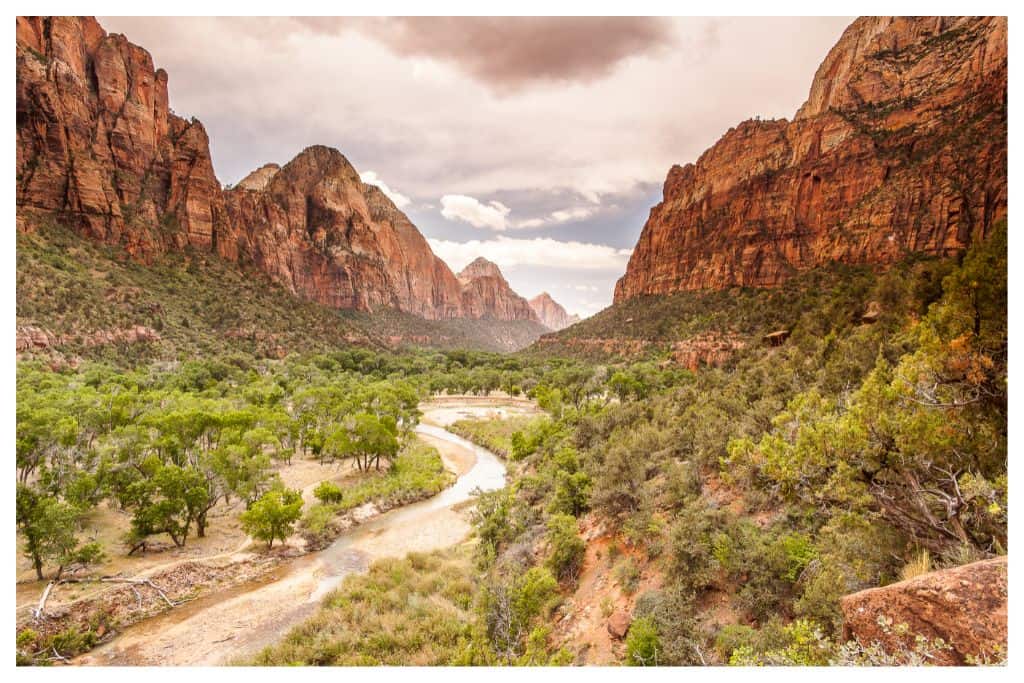
It is with good reason that Zion National Park is one of the most popular national parks in the United States. With its stunning red rock canyons, lush forests, and majestic waterfalls Zion is truly extraordinary.
One of the best ways to see the park is to take a scenic tour on the shuttle. During the busy season, the Zion Canyon Scenic Drive is only accessible by shuttle. The shuttle stops at all the park highlights, you can get off, take pictures and hang out for as long as you would like, and catch the next shuttle as it passes.
The most popular and well-known hike in the park is Angles Landing. While the views from the top of Angels landing are unaparrled, this is a challenging hike, at 5 miles long with 1,500 feet of elevation gain. Additionally, the trail to the summit winds along a narrow ridge with steep drops on either side, so this hike is not for young kids or those uncomfortable with heights.
The Zion Lodge is the only option for accommodation within the park. The park also has three campgrounds, Watchman, South, and Lava Point. Watchman is open year-round, with reservations being required from early March to late November, and first come first serve the remainder of the year. South and Lava Point Campgrounds are open seasonally.
31. Bryce Canyon National Park
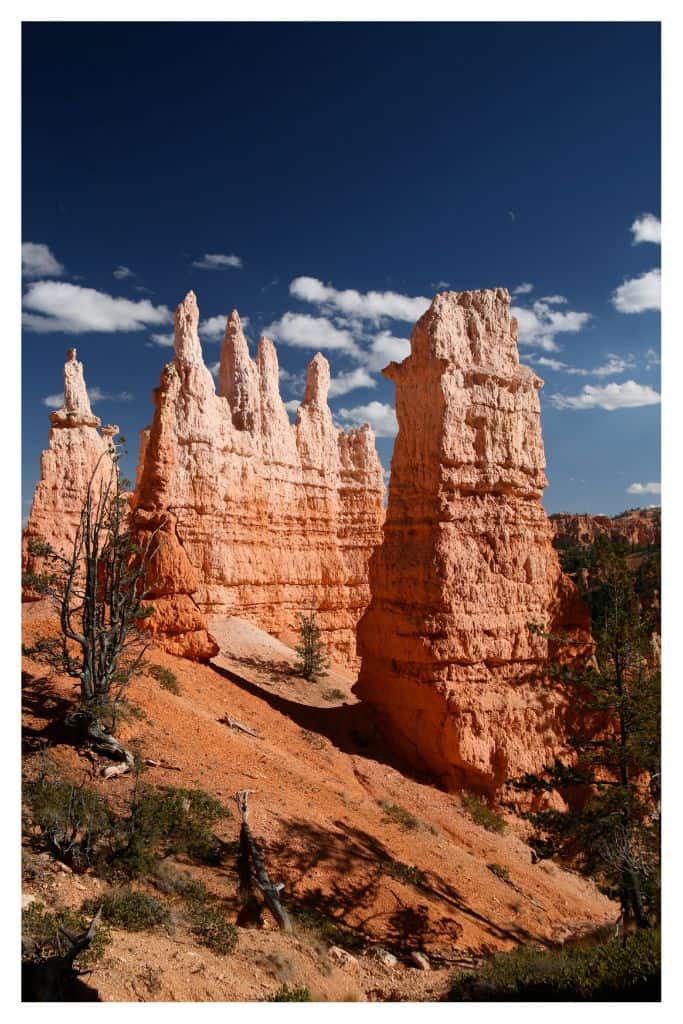
Bryce Canyon National Park is located in southwest Utah and is home to some of the most unique rock formations you will see. The towering red hoodoos can give an other-worldly feel.
Bryce Canyon offers plenty of family-friendly hiking opportunities that will help you appreciate the park’s beauty without straining your legs too much. One popular option is the Navajo Loop Trail, which is a 1.3-mile loop with an elevation change of 500 feet. The trail follows a ravine through several hoodoo formations and offers stunning views as well as educational signs along the way.
There are also plenty of shorter hikes such as Queen’s Garden Trail (1 mile) and Mossy Cave Trail (1/2 mile). For more experienced hikers, there are longer options such as Peek-a-Boo Loop (5 miles) and Fairyland Loop (8 miles).
The only option for accommodation within the park is The Lodge at Bryce Canyon. There are two campgrounds within the park. North Campground remains open throughout the year while Sunset Campground is only open during the winter.
Bryce Canyon is not far from Zion and both could easily be visited on the same trip.
Arizona
32. Grand Canyon National Park

There are few sites that have the ability to invoke a sense of awe and wonder like The Grand Canyon does. The scale simply cannot be comprehended until you have seen it in person. As beautiful as photos of the Grand Canyon are, they simply don’t do it justice.
The Grand Canyon has a max depth of 6,000 feet and a max width of 18 miles. The process of erosion that formed the Grand Canyon has been ongoing for 5-6 million years, which, believe it or not, in geological terms is actually fairly young.
However, some of the rocks found within the Grand Canyon are as old as 1.84 billion years! Looking through the different layers of rock in the Grand Canyon walls is like looking back in time.
To fully understand the significance of the Grand Canyon be sure to catch a ranger program during your stay.
There are many hiking opportunities in the Grand Canyon. Understandably many of them require significant vertical descent and ascent. While it is possible to hike all the way to the canyon floor it is an extremely challenging journey and is only recommended for the most experienced and well-prepared hikers.
As an alternative, you can reach the canyon floor via a mule ride.
There is lodging and camping on both the North and South Rim of the Grand Canyon. The South Rim remains open year-round whereas the North Rim facilities are open from May 15th through October 15th.
Conclusion: The 32 Best West Coast National Parks
That concludes our list of The Best West Coast National Parks.
There is no doubt that the West Coast of the United States is brimming with natural beauty. From the barren deserts of Death Valley to the glaciated peak of Mt Rainier there is something for everyone in the National Parks of the West Coast.
One could spend a lifetime exploring the western United States and not run out of things to do.
We hope after reading this list you will be inspired to get out and explore with your family, we sure are!
